SLEEPING FORMS
SOUTHERN AFRICAN HEADRESTS FROM THE KAREL NEL COLLECTION

www.jacarandatribal.com
dori@jacarandatribal.com
T +1 646-251-8528
New York City, NY 10025
© 2023, Jacaranda LLC
Published April, 2023
Editor: Elizabeth Burroughs
Photography: Liz Whitter
Photograph on p 6: Liz Whitter, courtesy Wits Art Museum
PRICES AVAILABLE ON REQUEST
2
ART AND ANTIQUES FROM AFRICA, OCEANIA AND THE AMERICAS
SLEEPING FORMS
SOUTHERN AFRICAN HEADRESTS FROM THE KAREL NEL COLLECTION
We are pleased to present Sleeping Forms, Southern African headrests from the collection of Karel Nel
A visit to Nel’s home in Johannesburg, South Africa, is a much-anticipated pilgrimage for passionate art lovers, collectors, and curators. Few private homes figure so prominently in the story of South African art as the Nel studio. His modernist home, Mudhif, alludes to the traditional reed structures of the Marsh Arabs of Southern Iraq, buildings that had inspired architect Norman Eaton and artist Alexis Preller, who had both owned the exceptional Zanzibari doors that Nel incorporated into his own home.
Mudhif is both a home and artist’s studio as well as a repository of an exceptional art collection, formed with care
and precision. It brims with contemporary and traditional art, not only from Africa, but also from the countries and islands in the Indian Ocean and the Pacific beyond, reflecting and incorporating Nel’s life as a traveler, collector, connoisseur, artist, and scholar. As the first in a series of online exhibitions of the Karel Nel collection, we are proud to offer an exceptional selection of southern African headrests.
We are personally honored to know Karel Nel, both as a friend and as a mentor, and take great pride in bringing his collection to the attention of the wider collecting public. We hope you enjoy the exhibition!
Dori & Daniel Rootenberg new york city, april 2023
3

KAREL NEL THE COLLECTOR ELIZABETH BURROUGHS
Collecting is a way of understanding the culture and society in which I grew up … a point of access for living on this continent, like learning a series of languages.
karel nel
Visiting Nel’s spacious Johannesburg studio is like entering another world. Its high, barrel-vaulted spaces open onto a tranquil central pool that reflects the embrace of the foliage cascading towards the water. The large glass panels slide away into the massive, mud-coloured walls, creating a seamless flow between the interior and the verdant garden.
A series of Zanzibari doors, combined with Nel’s interest in African architecture, influenced the design of his studio home. It serves both as a workspace and a foil for the objects that Nel has collected over a lifetime. Huge drawing boards slide back, revealing deep shelves containing coherent collections of headrests, ceramic vessels, ceremonial staffs, and other African and Oceanic objects, collected over many years and from all corners of the globe. The other interleading spaces in the house – the entrance hall, library, and the sleeping platform in Nel’s bedroom – are punctuated with a more permanent array of large objects, while constellations of smaller pieces are changed frequently throughout his home.
Nel’s interest in traditional Southern African art is reflected in his curated selection of objects. His collection of headrests, for example, is particularly directed towards ones that are sculptural in form. Similarly, the array of Zulu spoons or meat platters that Nel has collected, if laid
out, present a series of connected visual dialects, where the designs were masterfully honed over generations. The fluency evident in the pieces speaks of a long, continuous, and refined tradition of making. Likewise, Nel’s collection of Southern African ceramics has been chosen with an eye for the clarity and simplicity that comes from an intimate knowledge of the possibilities of the medium. One of Nel’s most focused collections brings together a range of fertility or child figures from Southern African groups such as the Ndebele, Ntwane, Shangaan, Swazi, and Tonga. These conical or cylindrical forms are adorned with beads or fine bracelets of golden grass and topped with striking fiber hairstyles. Lovingly made, these small objects were intended to evoke the presence of a longed-for child from the ancestral realm.
Nel has collected both in South Africa and abroad – a propensity that dates back to his childhood. While some of these Southern African pieces have been acquired in unexpected places such as Sydney, Paris, and New York, many were collected on field trips to the Limpopo and Eswatini, as well as from local collectors and dealers.
His interest in both Western art and objects from other cultures, whether sacred or utilitarian, has always been informed by his appreciation of the artistic skill and
5 karel nel the collector



conceptual complexity evidenced in the work of unknown makers from radically different times and places. Nel says frequently that what he collects influences how he thinks and his creative work, and that, conversely, his preoccupations and his art making direct his choices when collecting. For Nel, these objects of aesthetic value, even if they are not ‘precious’, generate a creative current, regardless of their date or origin, and which, in transmission, shift aesthetics, encourage new human understanding and elicit an aspirational influence in the present.
On a more personal note, Karel Nel was born in Natal, South Africa in 1955, where he was exposed at a very early age to the beauty of Zulu beadwork, basketry, and ceramic vessels which his parents had collected while both were lecturing at Indaleni, a teachers’ training college for black students in the KwaZulu-Natal midlands. Even as a young boy, Nel’s creativity manifested in countless bright drawings inspired by looking at Japanese and Egyptian art in his family’s books.
After completing a Fine Arts degree with a specialization in sculpture at the University of the Witwatersrand in Johannesburg, Nel did his post-graduate studies at St Martin’s School of Art in London, under Anthony Caro and Phillip King. He then went on to do a Masters at the University of California, Berkeley, where he considered the links between art and science, a lifelong interest. During his post-graduate studies, Nel travelled widely, looking at architecture and the sculpture, ceramics, calligraphy and visual arts housed in the great museums of the world, a practice that has remained integral to his life. His extensive travels included time in Polynesia and Micronesia as well
as the islands of the Indian Ocean on account of his interest in trading routes between Africa and Asia. During these travels, Nel visited places of great personal and cultural significance – he sought out sacred sites in Hawaii, Tahiti, the Marquesas and Easter Island, as well as the great sites of Nan Madol, Angkor Wat and Borobudur. He has also looked with great interest at headrests and bowls in different societies, at how wealth was variously created and stored in different cultural groups, and at how value becomes imbued, say, in a hand-made hunting net of baobab fiber in Zimbabwe or a very large stone disc on the island of Yap in the Pacific, or in the accumulated effort embodied in a forged iron hoe or an x-shaped, copper ingot in Central Africa.
Nel was for many years a lecturer and then a professor of Fine Art at the University of Witwatersrand, teaching drawing and sculpture. He has served on acquisitions committees at several museums, using his trained eye in helping put together informed collections. He has been an advisor on prominent exhibitions in France, the United States, and Britain, focussing particularly on Southern African material. He has also authored numerous essays in specialist books related to this field. In recent years, Nel has served as a Senior Curator at the Norval Foundation in Cape Town.
Nel’s artistic practice has spanned at least four decades, with exhibitions in London, Los Angeles, New York, and South Africa. His work is included in the collections of the Metropolitan Museum of Art, New York, the Smithsonian’s National Museum of African Art, Washington, DC, and the British Museum, as well as in various national collections in South Africa.
9 karel nel the collector

With regard to Nel’s interest in the relationship between art and science, he has, since 2004, been Artistin-Residence alongside a team of the world’s foremost astronomers on COSMOS, the Cosmic Evolution Survey. This ambitious project to map a two square degree field of the universe has been designed to probe the formation and evolution of galaxies as a function of cosmic time. Much of Nel’s own artistic work is informed by the ideas, insights, images, and raw data captured by the radio, infrared, optical, and x-ray telescopes used in the scientists’ research. Annually, Nel presents his thoughts, prompted by the astronomers’ lectures and discussions, to the COSMOS team, and offers observations based on his understanding of how new insights are represented in both art and science. In his lectures, Nel shares ideas and images that emerge from his own artistic processes. In fact, the titles of some of his exhibitions reveal how intimately connected his practice has become to the interactions with the astronomers – The Brilliance of Darkness, The Status of Dust and Lost Light.
Together with the astronomers of the team, Nel has closely followed the construction and launch of the new James Webb Space Telescope, which will become the main instrument of the COSMOS team’s ongoing investigations.
In Nel’s life, his roles as a teacher, curator, writer, collector, and artist have been inextricably bound up with one another, each of them infused by his awareness of how consciousness becomes manifest in the objects that humans create, whether they be a major drawing, a $10-billion space telescope constructed over a period of thirty years, or a wooden headrest allowing for dream connections between the present and the past.
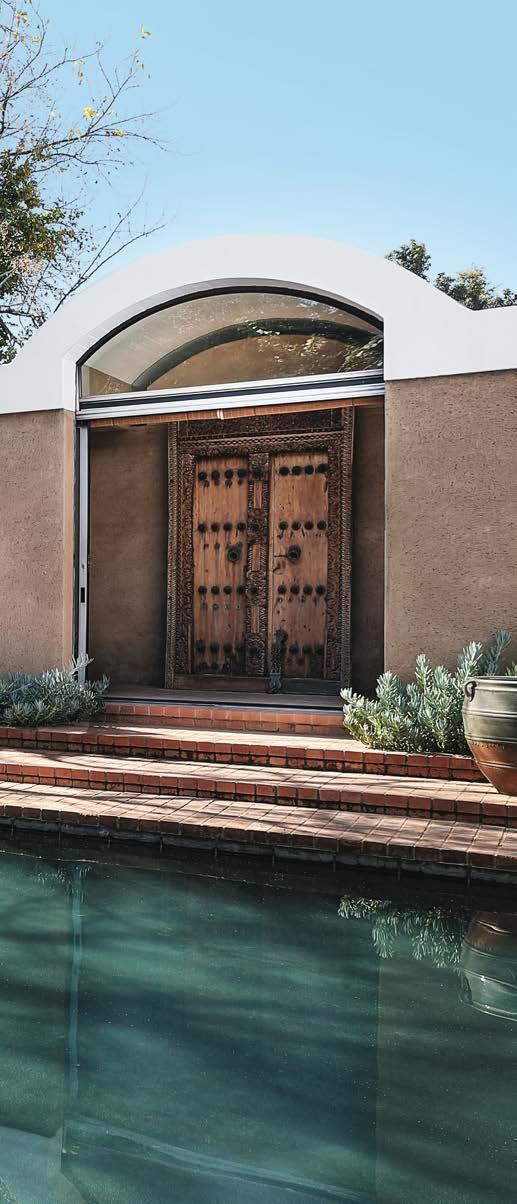
11 karel nel the collector
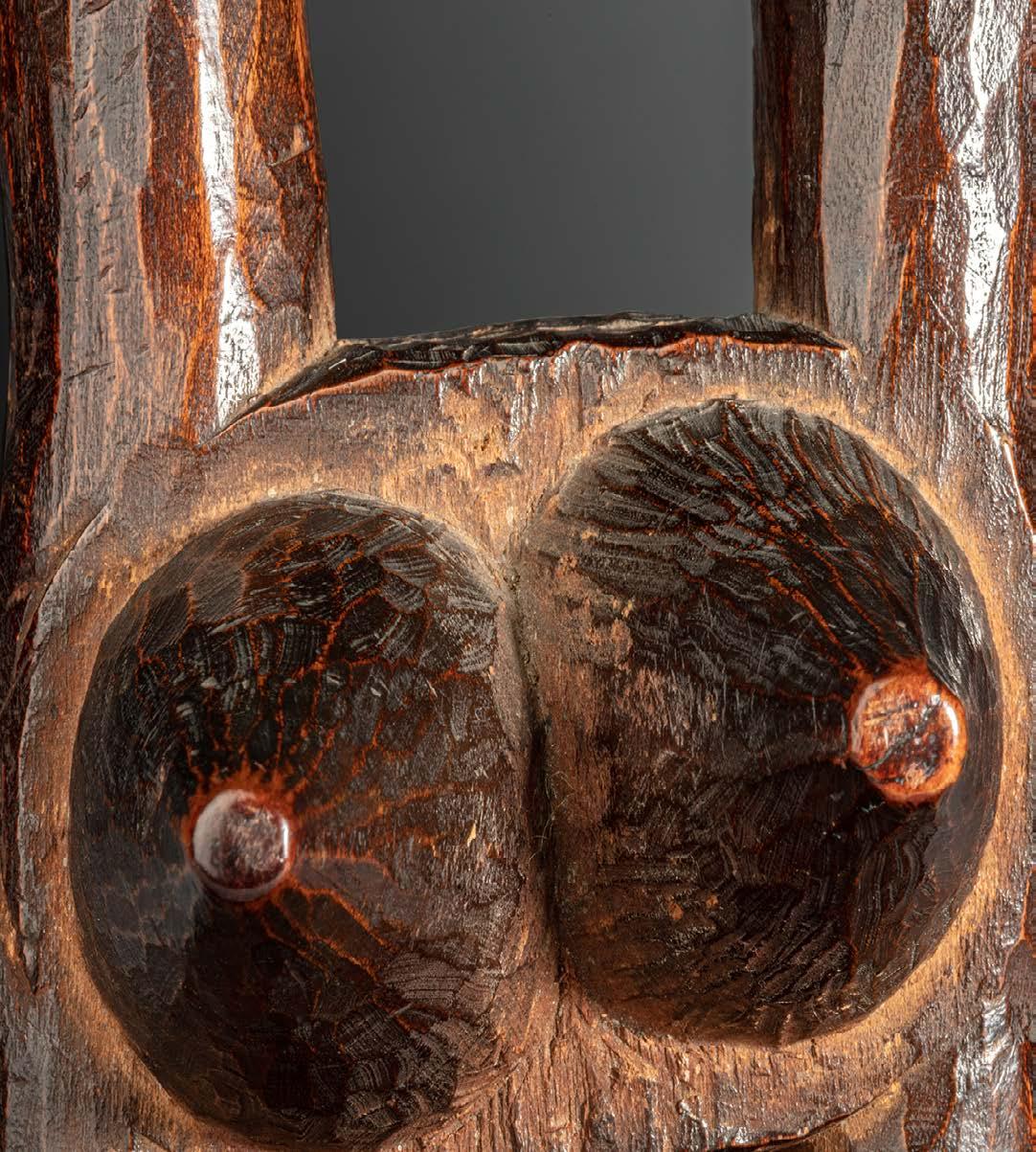
SLEEPING FORMS
SOUTHERN AFRICAN HEADRESTS FROM THE KAREL NEL COLLECTION
NESSA LEIBHAMMER
Introduction
While a piece of wood, a stone or a roll of animal hide might have served as a raised surface to rest the head on while sleeping, headrests, with their virtuoso carving, rich diversity of form, and deep patina acquired over many years of use, were treasured items, palpably significant. The idea that a headrest would lift the head of a sleeper off the ground and ensure that elaborate hairstyles would remain intact is obvious, but it is less apparent that both these pragmatic functions are interwoven in a nexus of extended signification. The lustrous surfaces and finely carved forms of the headrests point to an importance beyond everyday use. Symbolic meaning, evoked in their shapes, motifs, and materials, holds multilayered associations.1
Sleep, dreams, and the ancestors
Deeply embedded in African cosmological concepts is the belief that the ever-present spirits of departed family members exist on a parallel plane to those on earth. Never far away, these ancestors are understood to watch over their descendants, communicating with the living through dreams. Maintaining the respect for – and obeying the wishes of –these ‘shades’ was central to the well-being of individuals and their families. Headrests, by providing a conduit pleasing
to the ancestors with their familiar and alluring designs, performed a crucial function by bringing the sleeper’s head in contact with the earth, thus connecting the living with their forebears who dwell below. Attracting the ancestors with an appropriately carved headrest was believed to greatly increase the likelihood of success of such interchanges.
Headrests, handed down to sons or daughters, or buried with their owners, formed part of the archival memory of the family. Traces of the bodily presence of previous owners, emerging from years of use, forever became part of its physical fabric. The headrest, therefore, embodies a somatic connection to the ancestral family, of which the latest owner formed part of a continuum that defined them as an individual and as a member of a lineage. Because of a headrests’ ability to connect the realm of the living to that of the spirit world, diviners (sangomas/nyangas) harnessed this potency as one of the means to connect to their ancestral guides, further evidence of their importance as a link between the everyday and the intangible.
Acquired at, or just before, the wedding, a headrest served as a material manifestation of the transition into adulthood, and an affirmation of the marital union. Only married persons used headrests as they marked the stage in life when a person became a responsible adult, with a duty
13 sleeping forms : southern african headrests
to continue the family lineage – a sphere in which ancestors guided the catalytic life force. While headrests functioned in the private realm of the home, the change in marital status was more publicly declared by elaborate modes of hairstyling for both men and women. Hair, one of the most symbolically loaded zones of the human body, is specifically related to sexuality, procreation, and fertility.
Hair and the life-force
In Hair in African Art and Culture, archaeologist and historian Niangi Batulukisi writes that hair and the notion of the soul are inseparable.2 The conceptual synthesis of this vital energy and hair was further confirmed by William Siegmann, a curator and historian of the arts of Africa and Oceania. He explains that hair is thought to demonstrate ‘the life force, the multiplying power of profusion, prosperity and many children.’3 Leibhammer has similarly explored the extended symbolism of the connection between hair, water, and ancestral potency in Fluid of the Ancestors: Water and the Spirit Realm in Past and Present Black Southern African Thought and Practice.4 Here she follows lines of association that suggest connections between hair, ‘living’ water (ancestral fluids) and semen (both referred to as amalotha in Zulu). In line with these evocative associations, curator Manuel Jordan writes about the importance of hair and the head amongst the Chokwe of Central Africa. He describes how a mother’s head, especially her hair, is ritually treated during her son’s initiation, pointing to its symbolic association with his manhood. While the exact meaning has not been fully explained, it could be speculated that the regenerative qualities of the
14 sleeping forms : southern african headrests from the karel nel collection
mother’s hair may reflect hopes for continuity, success, and renewal.5
Writing about African coiffures, art historian William Dewey explains that there is the obvious motivation to adorn and beautify hairstyles that declare their owner’s age, gender, rank, or status, and that hair is also often embellished and/or empowered by accoutrements and charms of a magico-religious nature.6 These timeconsuming and delicate constructions, along with their embellishments, need to be protected during sleep. Headrests thus allowed the owners to sleep, dream, and commune with their ancestors without harming this embodiment of vital life energy.
Geographic spread and depth of time
Scanning the globe for regions where headrests are found, one may be surprised to learn that their use extends well beyond the African continent. Headrests have been used in places as distant as China, Japan, Papua New Guinea, Irian Jaya, and the islands of Fiji and Tonga. Predictably, these are places where traditions of elaborate hair fashioning are also found. From the cattle herders of East Africa, the nobility of China, the geishas of Japan to the agriculturalists of Irian Jaya, headrests and exceptional hairstyles were important elements of cultural identity. Intriguingly, there is no evidence of an equivalent headrest use in the Americas, nor Western Europe.
We may never know if the use of headrests – and the concomitant spiritual significance – traveled out of Africa with the first wave of human migrations. Modern humans, who evolved in Africa, seem to have left the cradle of
humankind, travelling north, and branching right, towards the east. The places where headrests have been found broadly follow this route of travel. Artist-collector and scholar Karel Nel writes that A conundrum exists as to whether headrests were spontaneously invented multiple times as a practical solution for raising the head off the ground for comfort during sleep, or whether their use became a cultural meme, a self-replicating rudimentary solution or idea that moved up and out of the cradle of mankind with the first outward migration of our species (105,000–45,000 years ago).7
Equally possible is that the locations of headrest use are evidence of cultural exchanges through trade to and from the East African coast, across the Red Sea, the Indian and Pacific Oceans, and overland along the Silk Road. These ancient routes were plied – over many millennia – until the axis of power swung towards the west in the 16th century. Evidence of these networks is provided in DNA research,8 and traces of shared musical and material culture traditions. While headrests are found over a wide geographic area, their first recorded use dates to around 5,000 years ago, to the tombs of ancient Egypt at the time of the Old Kingdom. While their presence may stretch even further back in time, there has been, to date, no evidence for this. It is intriguing that these ancient Pharaonic headrests, elegantly fashioned from alabaster, marble, or wood, are similar in style to some used in Ethiopia in the twentieth century. While it is usual to speculate that these Egyptian headrests were prototypes for those found in Africa, Dewey writes that there is ‘no evidence to show that the direction of influence was not from [Sub Saharan] Africa to Egypt.’9
15 sleeping forms : southern african headrests from the karel nel collection
The geographical zones on the African continent where specialized headrest use have been documented extend across sub-Saharan Africa. They were part of the fabric of life in early and medieval West Africa, a fact attested to by terracotta headrests found in Nigeria at Daima, dated to between the 8th to 12th centuries ce,10 and at Calabar, dated to the 15th century ce.11 The only wooden ones to survive from this period are those found in the dry caves of the Bandiagara cliffs in Mali and attributed to the Tellem. These headrests, dated between the 11th and 16th centuries ce, were an exceptional find since wood does not survive well in the harsh African climate and early antecedents are, as a result, rare. Headrests were in use in what is now Namibia, Angola, and the DRC on the western edge of the continent, along the northeast coast down from Egypt, through Sudan, Somalia, Ethiopia and Tanzania, Kenya and Malawi, to Mozambique, southern Africa and Botswana.
Headrests from the southern subcontinent of Africa
The focus here is on headrests found in southern Africa including Namibia, Zimbabwe, Mozambique, neighbouring Eswatini (formerly Swaziland), and South Africa. Within this region, an array of styles and types, many with overlapping and shared elements, makes the drawing of distinct stylistic boundaries a near-impossible challenge. There are, however, two broad configurations that provide some lines along which headrests can be parsed. Vertically aligned headrests were used by the Shona12 of Zimbabwe and the Tsonga from Mozambique. This configuration is also found further to the west in Limpopo
16 sleeping forms : southern african headrests from the karel nel collection
Province in South Africa, favoured as it was by the Ntwane and amongst the more distant Himba of northern Namibia. Headrests with long, horizontal forms, on the other hand, were associated with those living in the KwaZulu-Natal region and Eswatini. The present analysis is structured along these broad divisions, with further sub-categories noted in each group.
Many motifs
Within these two broad headrest groupings, an astonishing number of stylistic variations are found, testimony to the deep investment, ingenuity, and creative abilities of their makers. Allusions to the human body, wild and domesticated animals, geometric structures, and a combination of organic and abstract shapes that occasionally have a mechanistic reference, make up the sculptural vocabulary. The tendency of some upright headrests to suggest the female body is a much-discussed theme, while the long, horizontal format is largely seen to allude to cattle forms.
Issues of gender
In customary African societies, divisions along gender lines are generally well defined. In the material culture domain, men were responsible for carving wood and horn and for the smelting and forging of iron. Women worked with materials such as clay, grass, other plant fibers, cloth, and beads. These gendered relationships were not only linked to the materials themselves but also to the significance of the objects made.13 Headrests carved from wood were firmly in
the productive sphere of men, but they were not exclusively used by them.
There does not seem to be a unified set of rules along gender lines for the use of elaborate headrests within the southern African region. Amongst Zulu and Swazi communities, headrests belonged to and were used by both men and women. Art historian Rayda Becker writes that amongst the Tsonga, all married persons used headrests, and each generally owned one.14 However, amongst the Shona15 and the Himba, it is said that only adult men used intricately carved headrests while amongst the Bantwane, only women used them.
Attribution
It is important in the process of attribution to remember that headrests are sensitive to the micro-histories of kingdoms, chiefdoms, clans, families, and the individual rather than to the later overlay of modern national state boundaries. In the past, the collection of headrests without documentation of the carvers’ or owners’ identities led to generalised and often inaccurate attribution of these objects. However, some important documentary work has recently been undertaken that takes account of information at this personal level. Wherever possible, this will be reflected in the individual item descriptions below.16
The present array of headrests manifests the skills and repertoire of individual carvers and the desires of owners, and so, while they document the memory of earlier prototypes, they also reveal stylistic influences and innovations brought about by changes in social alignment, fashion, and taste.
17 sleeping forms : southern african headrests from the karel nel collection
sleeping forms : southern african headrests
18
UPRIGHT HEADREST FORMS
Headrests identified as Tsonga, Shangaan and Shona are generally taller than they are wide or have a squarish elevation. Those used by the Ntwane of Limpopo Province in South Africa and the Himba of Namibia share these proportions.
The term Shona loosely applies to the predominating group in the region south of the Zambezi and north of the Limpopo River. Shona-speaking people are not restricted to Zimbabwe alone but also live in surrounding regions, today known as Mozambique and Zambia, with headrests of a similar type also being found in Malawi. Tsonga people, likewise, are dispersed across wide regions of Mozambique, eastern Zimbabwe, northeastern South Africa, and Eswatini.
19

SHONA: ZIMBABWE AND NEIGHBOURING REGIONS
Headrests that fall within the Shona group have rectangular sleeping platforms that are longer than they are wide and curve evenly and gently upwards towards both ends. These upper sleeping surfaces are often embellished with single or parallel rows of ‘chip-cut’ or reverse relief zigzag lines at either end. Occasionally, the central section of this same surface has the cut-away shapes of two inwardly pointing triangles, made up in turn of smaller triangles, either carved in low relief or embellished with embedded copper or brass wire.
The curved upper surface on which the sleeper’s head rests is connected to the base by a central support panel that has a thin profile in contrast to the broader upper platform and base. Both sides of this vertical surface are decorated with low relief motifs of raised ridges and grooved channels: V-shaped patterns and concentric circle designs predominate, often in combination with square or rectangular shapes, that are in turn filled with other geometric designs. The motifs on the central support are seldom repeated exactly on its obverse side but show variation within a generalised format. The flat bases that steady the headrest are mainly configured as a double lobe or figure-of-eight, with chamfered sides that often reveal the refined paring away done with a tiny adze. On both sides of the base, a small projecting pubic triangle is carved at the point where the two lobes meet.
Much has been written on how visual cues on Shona
headrests reference the female body. This suggested allusion is borne out by the fact that only adult men slept on headrests of this type. Placing his head, the site of his ancestral lineage, on the ‘female’ headrest, created a metaphoric union between the ancestral lineage of the husband and the fertility of his wife, which was ceded to him from her father’s family line. From this union, the expectation was that children would be born.
The female allusion is reinforced by the delicate but prominent V-shape, emblematic of the female pubic area, incised on the base between the two (and occasionally three) abutting ovals. These elliptical shapes are said to allude to the female buttocks and thighs. Furthermore, the designs on the central upright have been interpreted as resembling the cicatrization (nyora) marks on women’s bodies that were acquired at puberty.17
Speculation as to the meaning of the concentric circular designs have varied, but Dewey, in his detailed and extensive research in Zimbabwe, explains that his sources have only ever referred to these as representing the circular designs of the base of the conus shell – an ornament referred to as a ndoro. These prized discs, with their central whorl, had political, economic, material, and spiritual significance. Ndoros were also associated with spirit mediums and so, once again, with the dream state and ancestral presences. Their carved representations on the headrests intensifies the power of the headrest as a
21
sleeping forms : southern african headrests from the karel nel collection I
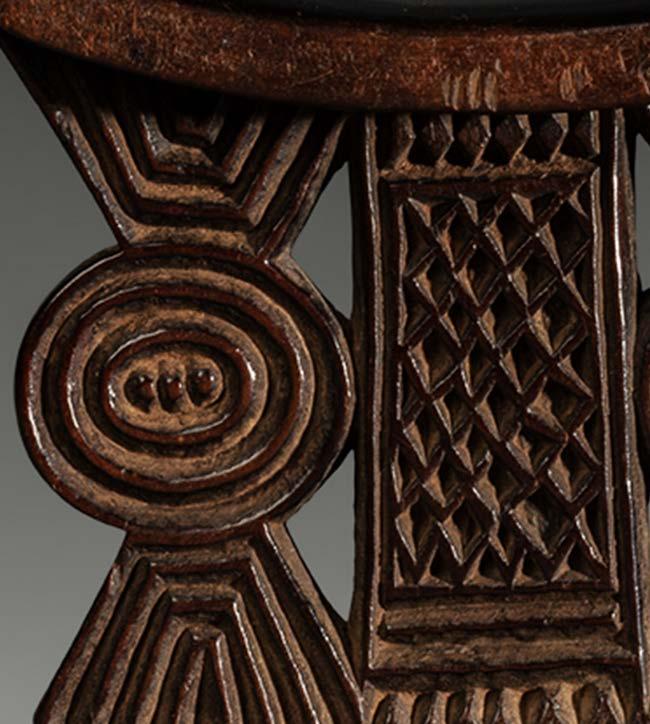
potent vehicle for communication with the spirit world. Amongst the Shona, only women’s bodies carry the emblematic marks of scarification. It is, however, especially curious that a married man would – after having slept on a headrest with chip-carved or slightly raised wire designs on the sleeping surface –wake with these imprints on his cheek. These ‘temporary’ scarifications, as with all body markings, are linked to identity and the ancestral lineage. If sufficient information were at hand, it would be possible to fine-tune the identity of headrests (mutsago) described as Shona as originating amongst one of the many polities and subgroups of the region that spread across Zimbabwe, Malawi, and Mozambique. These include the Korekore (or Northern Shona),18 the Zezuru,19 the Karanga20 and the Manyika.21 With the scarce and fragmentary nature of the information at hand, however, it is nearly impossible to place the headrests directly into any of these identity complexes, let alone ascribe them to families and original owners.
There are nevertheless a few instances where some distinctions can be made. In 1928, the German explorer and ethnologist Leo Frobenius photographed a ‘Nohwe Shona’ man demonstrating how to sleep using a headrest. The Nohwe are part of the Zezuru polity of central Zimbabwe. The headrest in Frobenius’ photograph bears a strong resemblance to No. 2 in this catalogue, and also to one in the British Museum (Accession number Af1950,04.4) said to have been collected in 1905 in Malawi by Dr Hugh Stannus Stannus (1877–1957).22 From the map, it is clear that the southern end of Malawi projects approximately 500 km into the northern section of Mozambique and runs parallel to Zimbabwe for part of this distance. These regions interlock with each other like a jigsaw puzzle and, since people in the past were not fixed within colonial boundaries, is it very possible that shared stylistic designs were common across these later demarcations.
23 sleeping forms : southern african headrests from the karel nel collection
ZAMBIA
ZIMBABWE
MALAWI
MOZAMBIQUE
SOUTH AFRICA
BOTSWANA
Lusaka Harare
Lilongwe

HEADREST : MUTSAGO
ZIMBABWE/MOZAMBIQUE/MALAWI
19th century
Wood
Height: 3.98 x Width 5.51 x Depth 2.48 ins (10.1 x 14 x 6.3 cm)
PROVENANCE
William (Bill) Wright, New York, USA
This small but perfect headrest, carved from a very hard wood, demonstrates an extraordinary graphic power. Its lustrous, dark surface, gently curving upper platform with its neatly incised designs, two-lobed base with chamfered sides, and central raised ‘V,’ make this an outstanding example of a classic Shona headrest. The vertical panel is precisely carved with three concentric circles in a row with raised bumps at their centers, and interlocking Vs above and below. Beyond this identification, it is a challenge to locate it within a more narrowly ascribed region or style type. Dewey has, however, established six style areas for Shona headrests23 and this example shows elements of both the ‘Central’ and ‘Eastern’ styles that he describes.
The features of the sleeping surface are specifically associated with Dewey’s Eastern Style.24 Not only is the upper platform surface decorated with the zigzag lines, it also has two inward pointing triangles, a feature not common in the other groups. Another unusual element is the three, rather than two, concentric designs without filler
areas between. Dewey illustrates only one example with three concentric designs which he places in the Central style region, and which, he notes, is very similar to the Eastern region.25
An example very similar to this one was exhibited in Africa: Art of a Continent at the Guggenheim Museum in 1996 and was reproduced in the catalogue.26 Müller and Snellerman illustrate four headrests on Plate XIV in their 1893 book, Industrie Des Cafres27 that closely resemble No.’s 1, 2, and 3 in this catalogue. These are recorded as coming from ‘Zambéze’ which is described as the basin of the Zambezi River from its mouth in the Indian Ocean, to Tete in Mozambique. This area abuts Zimbabwe to the west, Zambia to the north, and Malawi to the northeast. They, however, did not classify these headrests as Shona, but rather identified them according to the area in which they were collected. This region, with its closeness to the Zimbabwean border, would correspond with Dewey’s Eastern style.
25 headrest : mutsago 1

26 headrest : mutsago

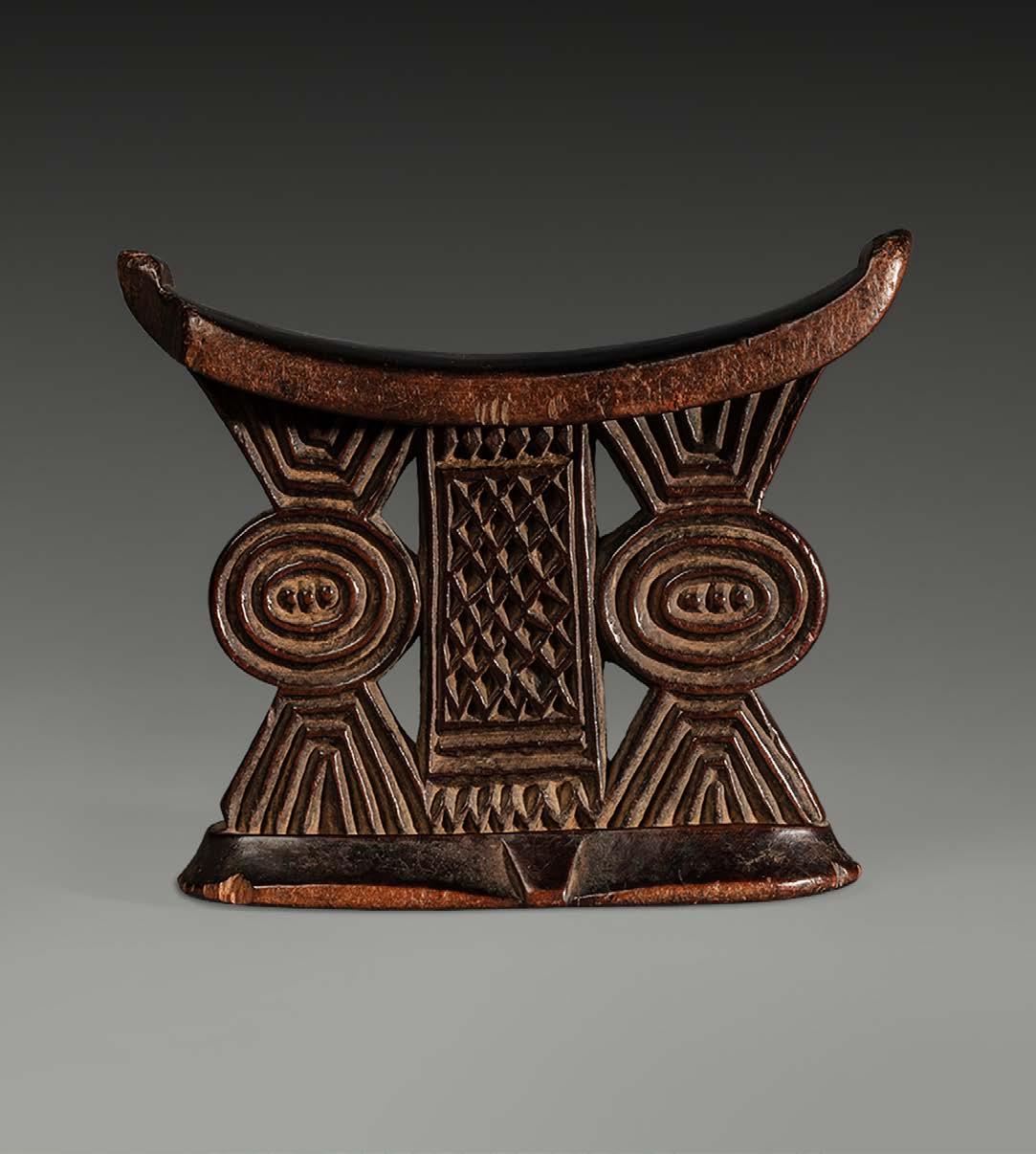
HEADREST : MUTSAGO
ZIMBABWE/MOZAMBIQUE/MALAWI
19th century
Wood
Height 5.39 x Width x 6.65 x Depth 1.81 ins (13.7 x 16.9 x 4.6 cm)
PROVENANCE
Udo Horstmann, Zug, Switzerland
This elegant Shona headrest is very similar to the one photographed by Frobenius in ‘Wanoe’ (Nohwe), a northeastern Zezuru area, in 1928.28 Both have a more rectangular base than that of the previous headrest (No. 1), and their two concentric circle designs are separated by a central, rectangular panel that is textured with raised, geometric designs. This striking example would then, most likely, belong to the Central Style
29 headrest : mutsago 2
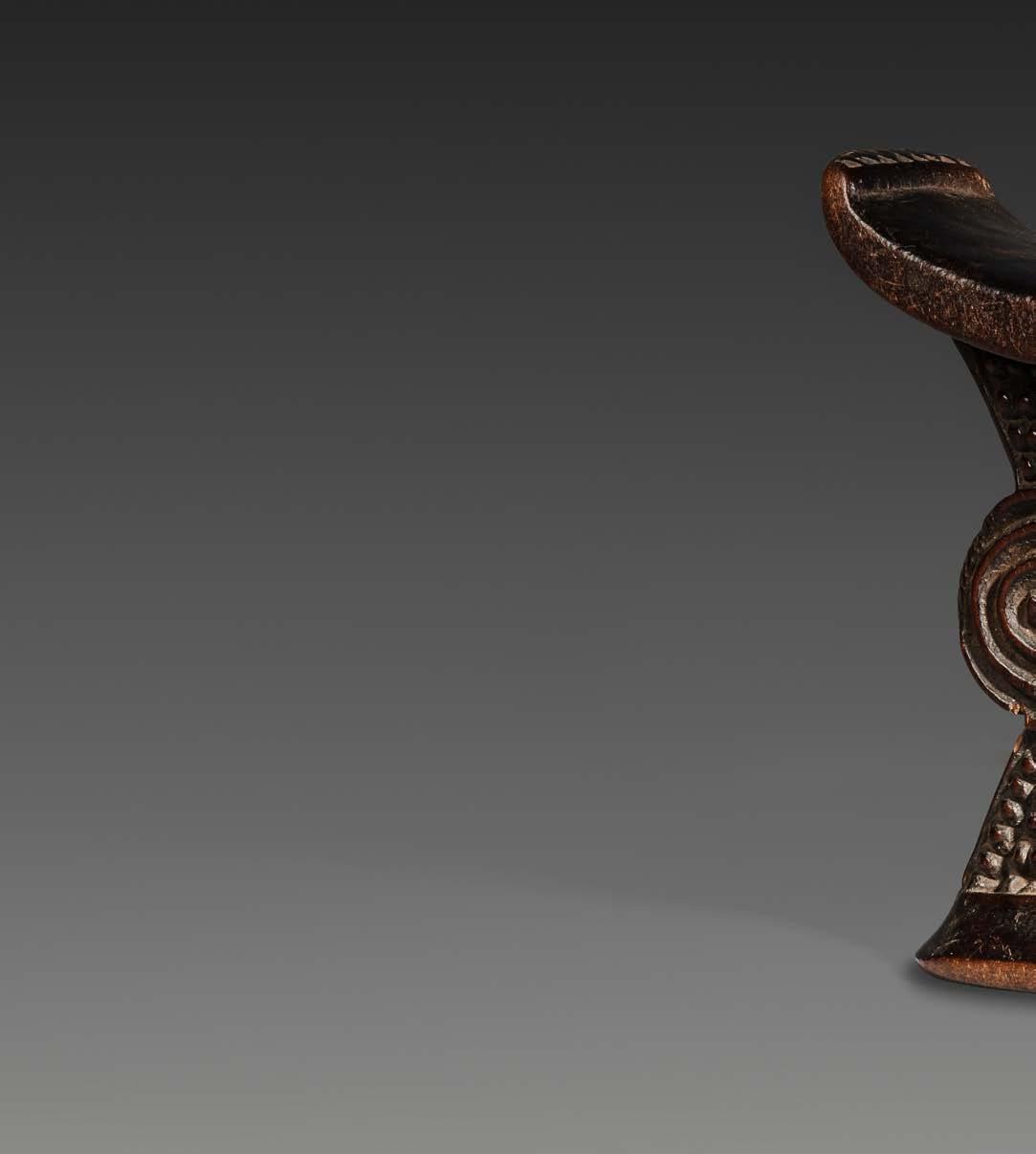

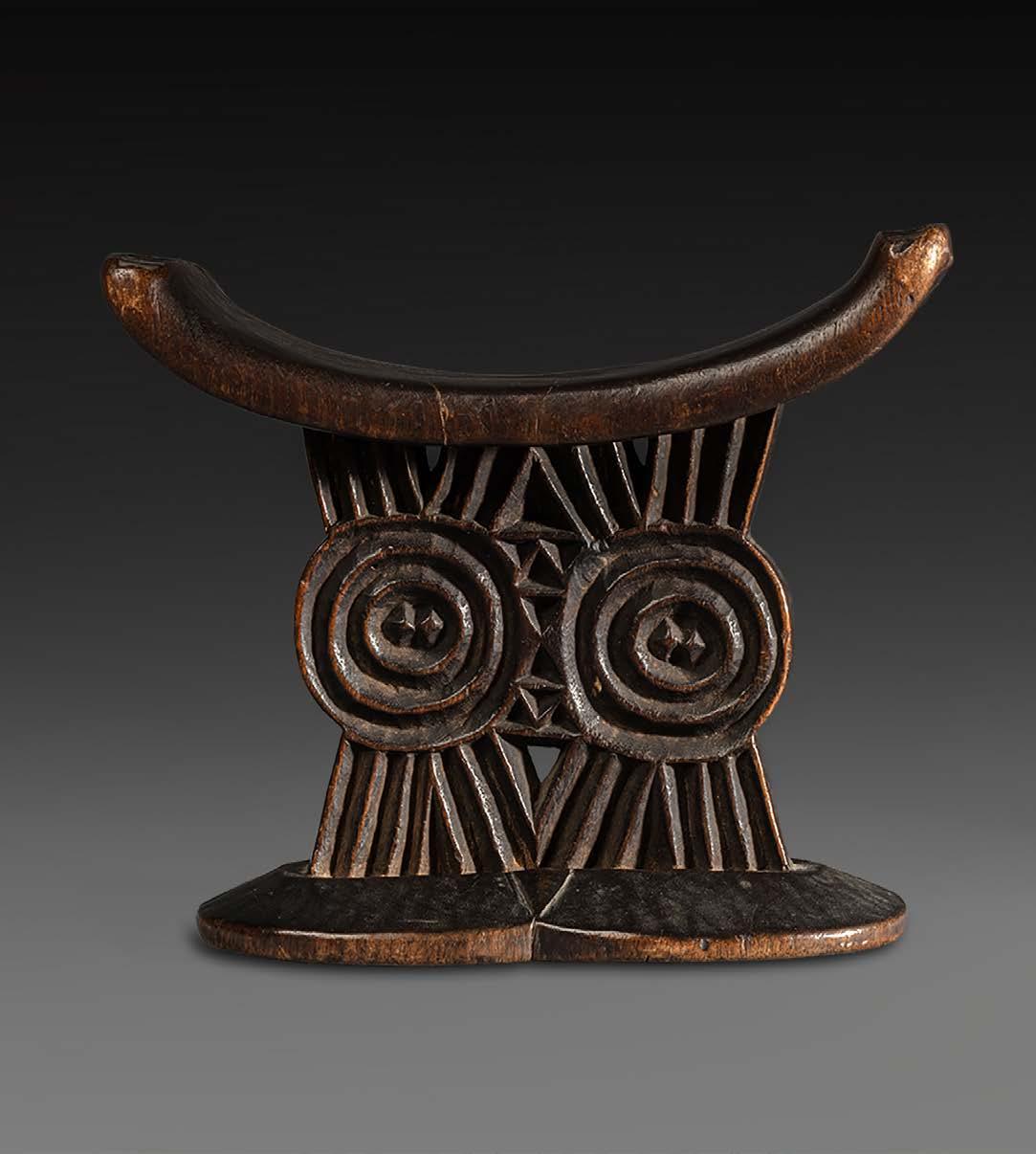
HEADREST : MUTSAGO
ZIMBABWE/MOZAMBIQUE/MALAWI
19th century
Wood
Height 6 x Width 7.24 x Depth 3.1 ins (15.3 x 18.4 x 7.6 cm)
PROVENANCE
Udo Horstmann, Zug, Switzerland
The central panel of this Shona headrest is embellished with two striking concentric circle designs, each with sets of stacked triangles above and below, thus following the general lines of this style. There is, however, no central rectangular panel as in the previous example (No. 2), but the two concentric motifs are joined by a small bridge of zigzag patterns in relief carving. The deftness with which has been carved and the patina acquired through many years of use, give the piece an almost metallic look which is immediately dispelled the moment one picks the headrest up and feels how light it is.
This headrest also has features that fit with Dewey’s Central Style. However, it has a more rounded base than the previous example (No. 2). All three headrests discussed so far are distinguished by a set of zigzag lines carved at either end of their sleeping platforms. While the circular designs on the central panel have been likened to ndoro rather than breasts, the overall gestalt does resemble of the human female form. This headrest also shares the typical figure-ofeight base with a centrally placed, raised triangular feature.
33 headrest : mutsago 3

34 headrest : mutsago


HEADREST : MUTSAGO
ZIMBABWE/MOZAMBIQUE/MALAWI
20th century
Wood
Height 5.59 x Width 6.61 x Depth 2.44 ins (14.2 x 16.8 x 6.2 cm)
PROVENANCE
Christopher Till, Salisbury Museum, Zimbabwe
Although unusual, this headrest nevertheless manifests several typical Shona characteristics: it has the curved upper platform, and the figure-of-eight base with chamfered sides. Both the platform and the base are thicker than in the other examples, with the central pubic triangle on the base positioned off the ground. The two concentric circles that form part of the central support structure are enclosed within a horizontal oval. This is, in turn, raised off the base by two conical struts and attached to the sleeping platform
by yet another two struts, thus leaving the oval medallion singularly evident. The medallion is further highlighted by the application of white ocher, emphasizing the concentric lines that resemble the eyes of an owl or some other spectral presence. The unusual use of white ocher on this headrest intensifies its symbolic association with the ancestral realm, beyond the regular, dark patina of the other three examples
37 headrest : mutsago 4


39 headrest : mutsago

TSONGA: ZIMBABWE/MOZAMBIQUE/LIMPOPO
Headrests that are identified as ‘Tsonga,’ ‘Shangaan’ or ‘Tsonga-Shangaan’ show an astonishing variety of styles within the overarching parameters of the upright format. This may be accounted for by the group having been widely dispersed for many centuries, often living amongst people with dissimilar cultural heritages. Many were also highly mobile as traders, hunters, and carvers, moving fluidly between the east coast and the hinterland.
Amongst the Tsonga, headrests were owned and used by both men and women, in contrast to their Shona neighbors where their use was exclusively male. This factor may also have contributed to the wider range of designs found amongst the group as the carvers were not limited to producing headrests that were mnemonics for the female form required by an exclusively male clientele.
Headrests defined as Tsonga include geometric forms as well as anthropomorphic and zoomorphic ones. Like the overall format found amongst the Shona, they also have rectangular sleeping platforms that curve gently upwards towards their outer ends. Some have chamfered, two-lobed bases with small, raised Vs nestled at the point where the lobes meet. Yet others have flattish rectangular bases without the characteristic V-shape. Tsonga headrests have a distinctive three-dimensional sculptural or architectural quality evident in the inventive forms of the supports connecting the upper platform to the base. Some, especially those with zoomorphic motifs, do not necessarily have solid
bases, but simply stand on the four legs of the ‘animal’.
The matching lugs or loops projecting down from both ends of the sleeping platform are a distinctive design feature of Tsonga headrests. These lugs are identified as ‘ears’, an interpretation corroborated by the presence of strings of beads threaded through the lugs in some intact examples. This adornment mirrors exactly the beaded earrings worn by Tsonga women.29 The notion of ‘hearing’ the ancestors during dreams, facilitated by these small sleeping devices, makes the inclusion of ‘ears’ a compelling feature, an element also found in many Swazi examples though fashioned differently.
It is worth noting that Swiss missionary Henri Junod was largely responsible for asserting a ‘Tsonga’ identity to these diverse peoples in the late 19th and early 20th centuries. His criterion for alleging cohesiveness was that they spoke a related language, Xitsonga. However, he acknowledged they had little sense of themselves as a group or nation.
Historian Patrick Harries explains how their disaggregation was exacerbated during the natural and political disasters of the nineteenth century. At this time, the inflow of Tsongaspeaking migrants from Mozambique into South Africa intensified and they settled under virtually every chief30 living on the escarpment and eastern highlands.31 Nettleton discusses the Tsonga capacity for adjusting to the stylistic preferences of the groups that they lived amongst, making a ‘Tsonga’ style fluid, and varied,32 within broad parameters.
41
II
sleeping forms : southern african headrests from the karel nel collection

HEADREST : XIKHIGELO
ZIMBABWE/MOZAMBIQUE/SOUTH AFRICA
19th century
Wood
Height 6.49 x Width 6.65 x Depth 3.35 ins (16.5 x 16.9 x 8.5 cm)
PROVENANCE
Michael Graham-Stewart, London, United Kingdom
The pair of firmly pointed, conical breasts, centrally positioned in a horizontal oval and supported by two upright columns, is brazenly engaging, and undoubtedly the most striking feature of this remarkable piece. Their presence validates the hypothesis that some headrests are mnemonics for the female body. A similarly breasted headrest in the British Museum was carved without lugs and with a deep V centrally located at its base. It is said to come from Mashonaland in Zimbabwe. However, the collector is not known, and the donor was a London
antique dealer who had never traveled to the region, so this provenance cannot be taken as certain.
This headrest, besides its overt female characteristics, has a flat, even, lozenge-shaped base without chamfering or a raised pubic triangle. Its sleeping platform is rectangular and curves gently upwards towards either end. From both these ends, the classic Tsonga ‘lugs’ or ears project downwards. Apart from the pert breasts, which are the focus of attention, the other surfaces are austere and undecorated.
43 headrest : xikhigelo 5

44 headrest : xikhigelo

45 headrest : xikhigelo

HEADREST : XIKHIGELO ZIMBABWE/MOZAMBIQUE/SOUTH
AFRICA
19th century
Wood, metal, glass, fibre, elephant- and wildebeest tail hair
Height 5.35 x Width 5.62 x Depth 2.63 ins (13.6 x 14.3 x 6.7 cm)
PROVENANCE
Michael Graham-Stewart, London, United Kingdom
Outstanding not only for its elegant torqued and crossed struts forming the support for its sleeping surface and for the finely carved rows of zigzags on its two lugs, this ‘dressed’ headrest is also an extremely rare example that has retained the embellishments added by its original owners. These additions are not merely decorative but add power to the object. Twisted and bound around its middle are three types of metal chain – a finely linked rusted industrial ball-chain whose surface has oxidized to a reddish hue, a chain of small dark metal links, and a circlet of handmade chain with large circular loops. White glass
buttons, threaded together on elephant hair, are draped across the one side. The rectangular chamfered base is twisted at a slight angle to the sleeping platform, an aspect of the design that is most unusual and possibly a result of the torquing of the wood as it dried. The base includes a low relief triangle darkened with poker work at the center of both front and back. As the raised, central triangle is considered a distinctive feature of Shona headrests, and the lugs typical of a Tsonga style, this headrest demonstrates how classificatory boundaries drawn along clear stylistic lines need further consideration.
47 headrest : xikhigelo 6

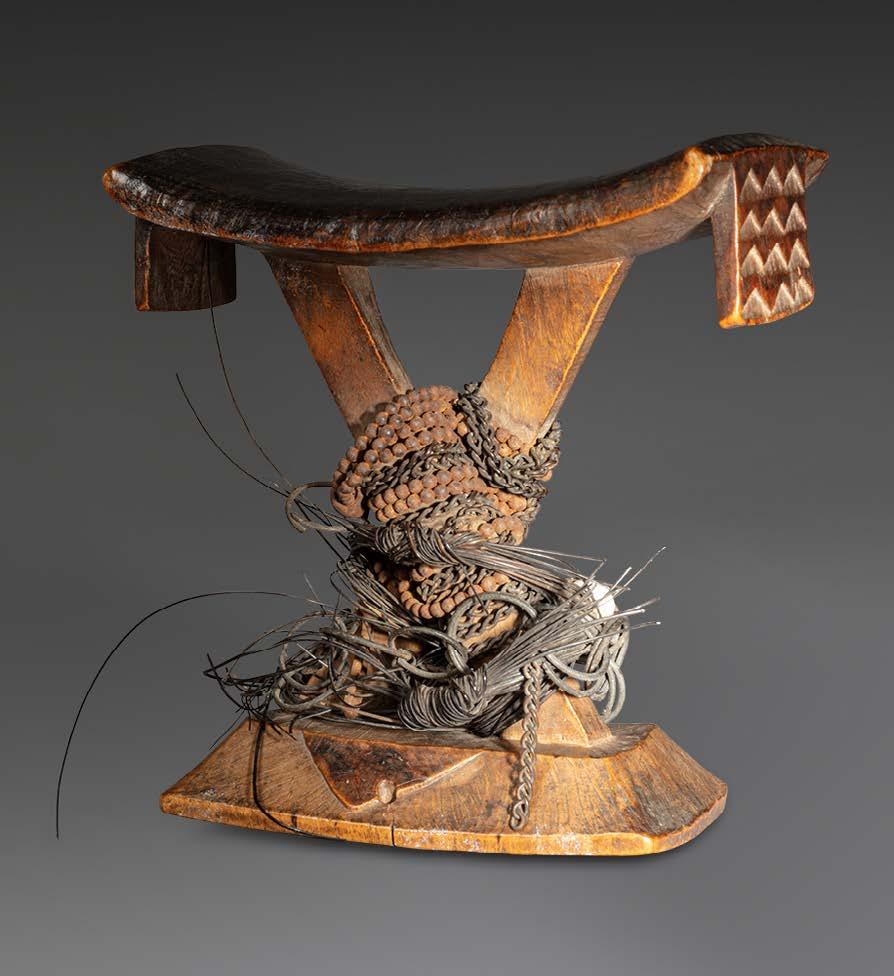
49 headrest : xikhigelo

HEADREST : XIKHIGELO
ZIMBABWE/MOZAMBIQUE/SOUTH AFRICA
19th century
Wood, pokerwork
Height 4.92 x Width 6.45 x Depth 2.99 ins. (12.5 x 16.4 x 7.6 cm)
PROVENANCE
Udo Horstmann, Zug, Switzerland
Three light colored columns, balanced on the back of an arc of darkened wood, seem to brace themselves to the work of holding up the sleeping platform of this headrest. Together, the arc and the columns comprise an unusual central panel. The arc spans the distance between the outer edges of the double-lobed base. The two lobes themselves feel splayed out by the force of the load above with their spreading chamfered sides and, in connecting with each other, create a definite indent on either side of the base. In fact, the gestalt of the headrest seems like a zany ideogram for a person carrying a load – a caryatid.
This headrest resembles an example in the Musée d’Ethnographie de la Ville Neuchatel, collected by Henri
Junod in the late 19th century. He had identified it as ‘Ronga’, a group that lived around the Delagoa Bay area.33 Its museum accession date is 1892 and it is also illustrated in his The Life of an African Tribe.34 Junod’s example has strings of animal teeth, bird’s claws, metal and glass beads draped about its ‘torso’ in much the same way as the previous example (No. 6) has.
This headrest also bears a strong similarity to two examples in the Johannesburg Art Gallery collection,35 which are documented as having been collected by the Rev. AA Jaques for the Suisse Romand mission school at Lemana in modern-day Limpopo, about 100 km south of Zimbabwe and 100 km west of the Mozambican border.
51 headrest : xikhigelo 7


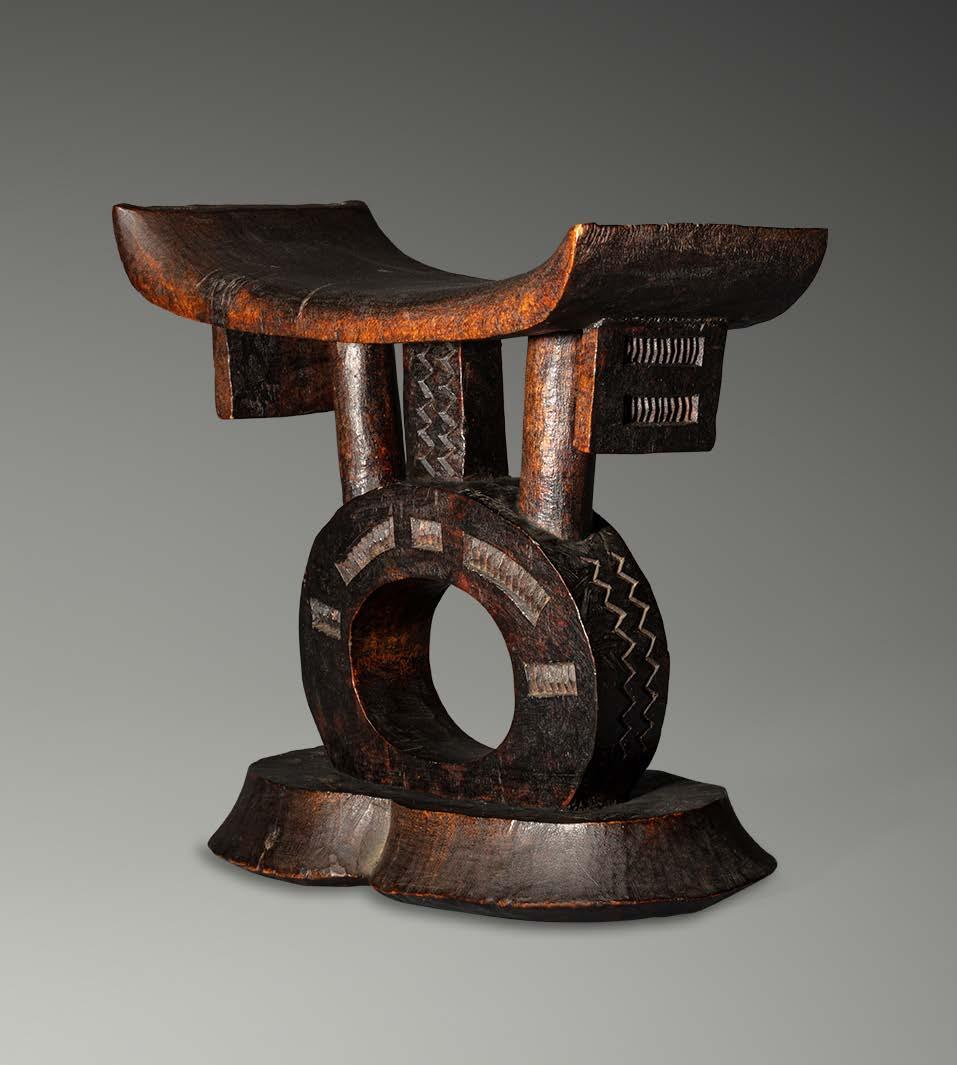
HEADREST : XIKHIGELO
ZIMBABWE/MOZAMBIQUE/SOUTH AFRICA
19th century
Wood, pokerwork
Height 5.51 x Width 16.4 x Depth 2.95 ins (14 x 16.4 x 7.5 cm)
PROVENANCE
Udo Horstmann, Zug, Switzerland
This dark headrest of hard wood bears a strong ‘family’ resemblance to the previous one, but the differences are telling. Here, for example, the arc has become more circular, and the middle strut is rectangular rather than column-like. Finely carved incisions embellish both the rectangular ‘neck’ and the rotund ‘body’. The lugs that hang down gracefully from the sleeping platform have also been incised with two horizontal rectangles, constituted by very fine vertical lines. The two chamfered lobes of the base also seem to spread outwards under the load in the same way as the example above. However, the patina on this headrest is much more uniformly dark than is the case in the previous example (No. 7).
55 headrest : xikhigelo 8


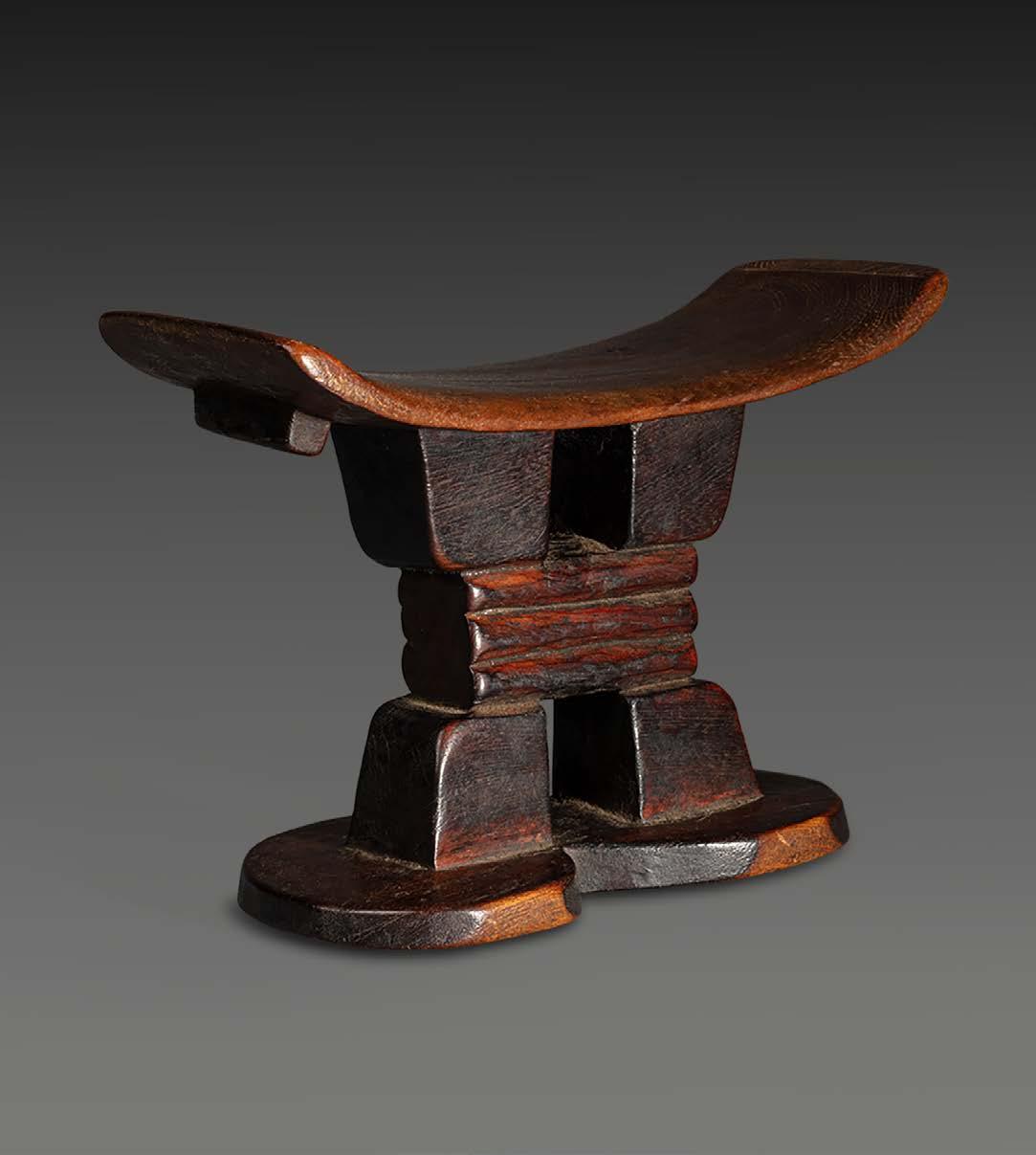
HEADREST : XIKHIGELO
ZIMBABWE/MOZAMBIQUE/SOUTH AFRICA
19th century
Wood, pokerwork
Height 4.92 x Width 7.48 x Depth 2.75 ins (12.5 x 19 x 7 cm)
PROVENANCE
Graham Ivy, Ivy’s Curios, Johannesburg, South Africa
Each of the four headrests above suggests, through its configuration, the human form. However, this analogy is most evident and stylized in this headrest. Two chunky, abstracted legs stand firmly on a flat, two-lobed base. The rectangular ‘legs’ narrow towards the central ‘waist’, which takes the form of a neatly grooved rectangle. A set of two sturdy ‘arms’ that mirror the shape of the legs, hold up the generous but refined upper platform. With its two lugs at either end, the sleeping surface is notably lighter in color
than the central panel. The notion of an ‘anthropomorphic caryatid,’ latent in other Shona and Tsonga examples, is most convincingly articulated in this example.
On the side of the headrest facing away from the camera, the base has been deliberately broken, an act which sometimes occurred at the death of the person to whom it belonged, done to release the spirit.
According to Mr Ivy, the dealer from whom the headrest was bought, it had been collected in Mashonaland.
59 headrest : xikhigelo 9



HEADREST : XIKHIGELO
ZIMBABWE/MOZAMBIQUE/SOUTH AFRICA
19th century
Wood, pokerwork
Height 5.51 x Width 7.4 x Depth 3.74 ins (14 x 18.8 x 9.5 cm)
PROVENANCE
Lesley Sacks, Los Angeles, USA
The lower portion of this Tsonga headrest resembles a tiny table with four sturdy columns for legs. From the tabletop with its fluted edges, three cylindrical columns emerge to support the curved upper sleeping platform. Its warm honey-colored shape is adorned with the two neatly decorated lugs at either end. The flat, figure-of-eight base is unusually broad, wide enough to accommodate the four legs. When taken as a whole, the complex superstructure with its columns and bases has a definite architectural quality to it, and yet it also has an animal-like quality on account of the four legs and the downward pointing lugs. While not identical, this example bears some resemblance to a headrest, illustrated by Distant in his book, A Naturalist
in the Transvaal (p 103), which he classified as Magwamba, a Tsonga-speaking community living in the Spelonken area of Limpopo Province. Two examples in the Musée d’Ethnographie de la Ville Neuchatel, are similar. One, documented as BaKhosa, was collected by the Swiss missionary Phillipe Jeanneret around Antioka near Lourenco Marques, and the other is said to come from the BaHlengwe, which Junod notes as being the largest group amongst the Tsonga, living north and east of the Limpopo River. Both headrests were accessioned in 1894. A headrest with a very similar configuration also appears in Art and Ambiguity but varies in its detailing.36
63 headrest : xikhigelo 10
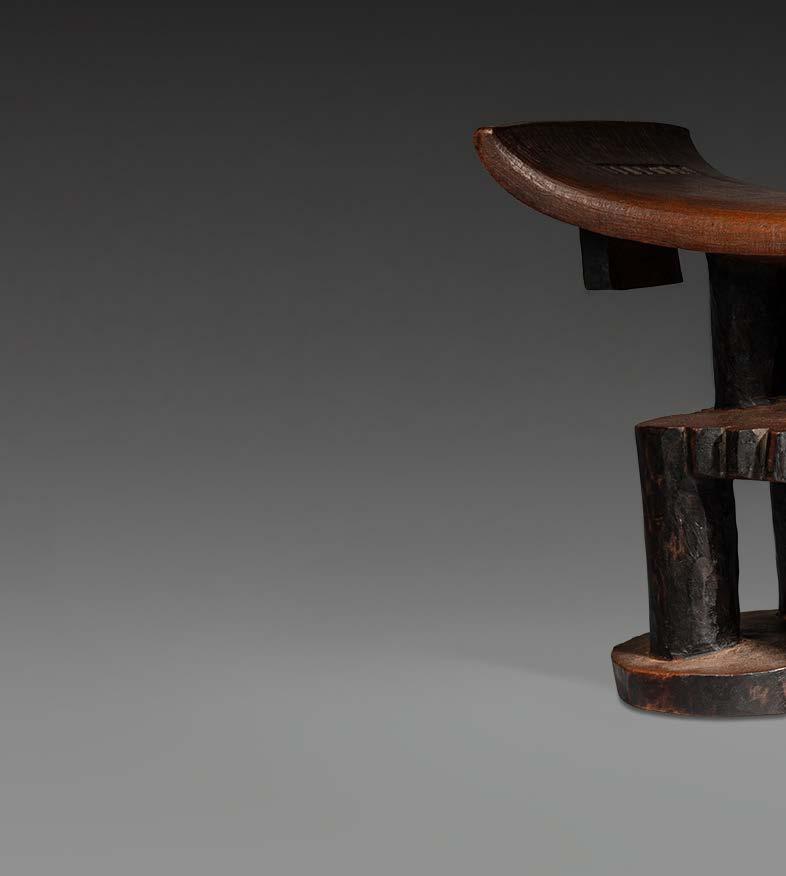


PAIR OF HEADRESTS : SWIKHIGELO
ZIMBABWE/MOZAMBIQUE/SOUTH AFRICA
PROVENANCE
Michael
Heuermann, Cape Town, South Africa
Jonathan Lowen, London, United Kingdom
This pair of headrests is sumptuously interlinked with not one, but two sets of chains, painstakingly carved of wood. The artistry and planning required to carve both headrests and the intervening chains from a single length of wood attests to the maker’s skills. The upper platforms are gently curved in opposite directions to facilitate the comfort of the sleepers, indicating that they would not sleep side by side but with their bodies positioned on opposite sides of the headrests and their heads intimately close to one another. Indeed, these headrests show a degree of wear consonant with two individuals using them at the same time.
The ends of the upcurves are delicately incised with a series of raised dots and darkened with pokerwork. The two outer edges of the sleeping platforms have semi-circular lugs carved with spiral designs, while the inner lugs, also of the same shape, serve as the connecting surface for the upper chain that joins the two headrests. The lower chain is connected to the chamfered, two-lobed bases, each of which has the typical V shape where the lobes meet.
The central panels of the two headrests are carved in an identical design, but being hand-carved, are not exactly the
same. The ‘caryatid’ form consists of a central rectangular upright that intersects two arcs, one curving down onto the base and the other reaching upwards to support the sleeping platform. The outer surfaces of the arches and the vertical struts have carved decorations and a whorl that resembles the design on the lugs at the point where they meet.
Much has been debated as to the meaning and purpose of headrests joined together by chains. Nel has explained how acquiring paired headrests was a betrothal custom where the objects explicitly demonstrated the connection between husband and wife and between the lineages of both families. This double headrest is perhaps a declaration of an even greater degree of commitment to the union. The virtuoso carving is surely an indication not only of the pride in owning such an object but in the reverence for the ancestral associations that attach to its presence.
Images of two identical examples are reproduced – one in Art and Ambiguity 37 and the other in The Art of Southern Africa: The Pethica Collection,38 both undoubtedly by the same carver.
67 pair of headrests : swikhigelo 11
19th century Wood, Height 5.75 x Width 24.8 x Depth 2.83 ins (63 x 14.6 x 7.2 cm)



NORTHERN KWAZULU-NATAL, MOZAMBIQUE, EAST AND CENTRAL REGIONS
These two headrests do not have firm provenances, but No 12 may originate amongst the BaChopi who lived south of Inhambane on the coast of Mozambique between the Limpopo and the Inharrime Rivers. Junod writes that, while
they are not part of the Tsonga group, they are related and speak a mutually understandable language. No. 13 is more challenging to identify and could come from a wide range of places, anywhere from Mozambique into eastern Zaire.
III
sleeping forms : southern african headrests from the karel nel collection 71

HEADREST : XIKHIGELO MOZAMBIQUE/SOUTH AFRICA
19th century
Wood, pokerwork
Height 5.6 x Width 7 x Depth 3.6 ins (14 cm x 18 cm x 9.5 cm)
PROVENANCE
Udo Horstmann, Zug, Switzerland
A strong cylindrical central structure balanced on top of a curved, rectangular base, and a sleeping surface above with the typical downward-pointing lugs, all suggest a Tsonga provenance. However, the rectangular base has a surface that curves from front to back with the highest point at its centerline, an unusual feature. Several similar examples exist in collections and have been variously identified as North Nguni, Zulu, Tsonga, Thonga, and Shangaan. For example, three similar headrests are illustrated in The Architecture of Sleep,39 all without known provenance. While these have the central circular support, they vary in the presence or absence of lugs, and in the base designs.
Two analogous to this example are published in Art and Ambiguity, identified as North Nguni and North Nguni/ Tsonga;40 one with a standard rectangular base appears in the Pethica Collection41 and one in The Art of Southeast Africa has two brass studs nailed into the front center of its circular support.42 The publication, Sleeping Beauties, includes a comparable example which has triangular chipcarving around edges of the circle and the base, as do many of the other examples listed above.43
As with No. 9 (above), the base of this headrest has been broken, either deliberately or accidentally.
73 headrest : xikhigelo 12

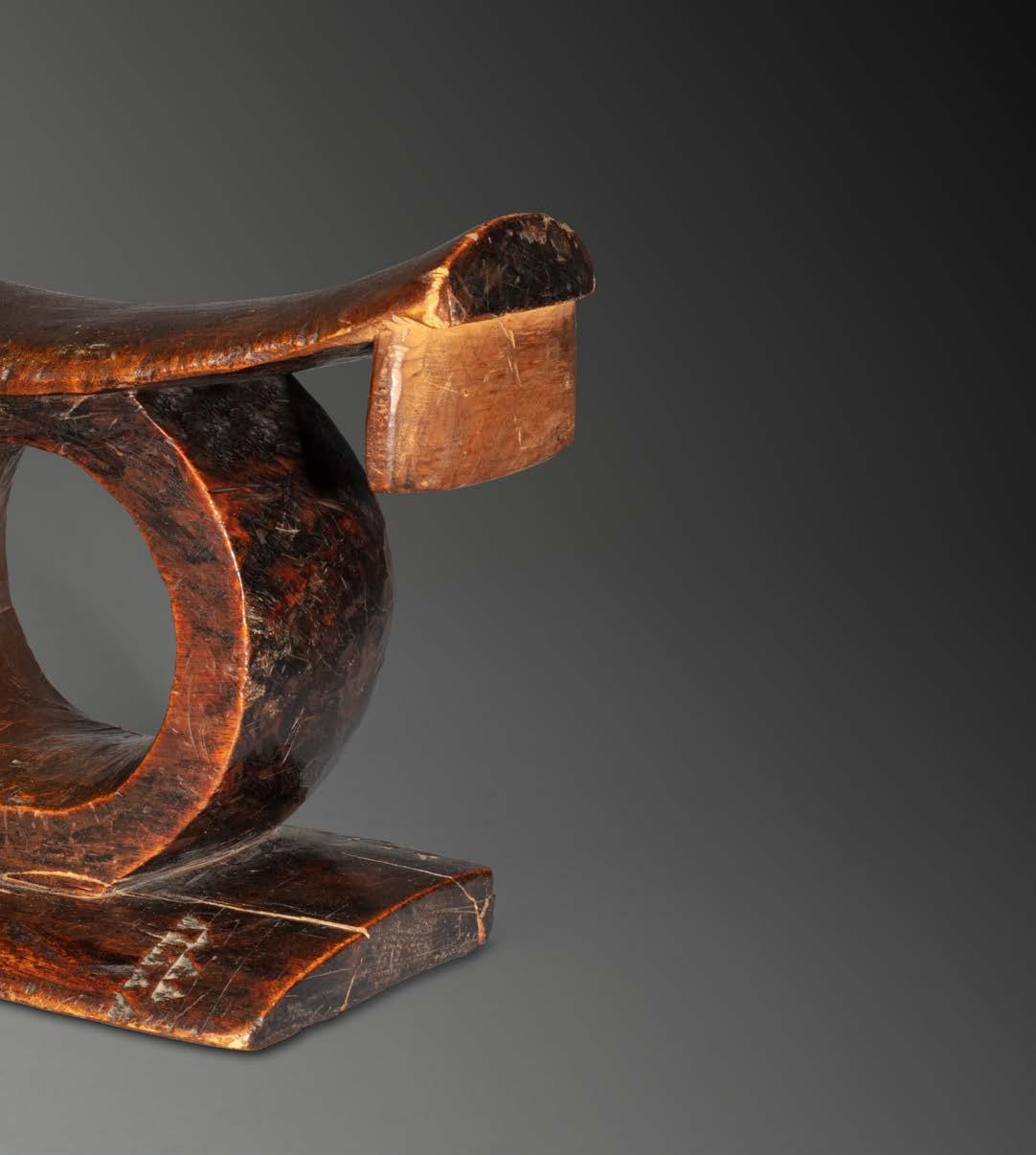

HEADREST : XIKHIGELO
ZIMBABWE/MOZAMBIQUE/SOUTH AFRICA
19th century
Wood, pokerwork
Height 5.51 x Width 6.69 x Depth 4.33 ins (14 x 17 x 11 cm)
PROVENANCE
Egon Guenther, Johannesburg, South Africa
Two arches, at right angles to one another, one facing upwards and the other downwards, join at their narrowest points to create a dynamic, inter-linked structure to support a curved upper platform. The lower arch is deeply grooved, adding to the visual complexity of the headrest. Its dramatically long lugs curve downward and are joined to the circular base.
Consequently, the base of the headrest feels unusually contained, clamped as it is between the ends of the downward arch and the flared lugs which are ‘attached’ to the base by rectangles of wood left in place during the carving process. The lugs are richly embellished, each divided into three zones – a plain central section is
flanked by the two outer sections, carved in a diamond and v-shaped, coffered grid design.
The concave sleeping platform has a visual weight and seems to form a continuous surface with the two lugs that are ‘draped’ over the upturned arc. The headrest is unusually compact and the complex component forms seem to be in a state of tension.
An almost identical headrest appears on p 206 of Africa Art of a Continent and is said to be ‘Probably Tsonga-related group, South Africa.’ The difference lies in the decoration on the extended lugs and the rectangles below, which, on this example, are striated horizontally.
77 headrest : xikhigelo 13

78 headrest : xikhigelo


NTWANE: LIMPOPO
The Bantwane, whose forebears are from Botswana, spent more than 100 years as migrants in the Limpopo and Mpumalanga regions of South Africa. Eventually, in the early 1900s, they were able to buy farms in the Moutse/ Dennilton area of Limpopo and their descendants still live there. Their lives and homes remain the sites of daily observances that secure the favors of their ancestors, and they are known as fiercely independent people. The name Ntwane means ‘hard-headed’ or ‘warrior’, which may also relate to the hairstyle (tlopo) once worn by married women.
Only Bantwane wives slept on headrests (metamelo), and sometimes still do, a necessity not only because of the elaborate sloping hairstyle (tlopo) adopted at marriage but also because of the many tiers of beaded rings that were worn around the neck. Quite distinctive from any other hairstyles in the region, the tlopo was constructed with clay worked into the hair and sculpted into a helmet-like form that seemed to lift off and float just above the head. Before
it was dry, the upper surface was incised with geometric designs and, after hardening, was dressed with specularite, an alluvial mineral deposit from riverbeds. This mineral, with its shimmering gunmetal silver, was always associated with ancestral presence. Small circular beadwork decorations (sehlora) were sometimes attached to the hairstyle. The dramatic stack of beaded neck rings that Bantwane women wore were considered dignified and elegant, elongating the neck, and creating a graceful presence.
The fragile hairstyle and the multiple beaded neckrings made the use of a headrest while sleeping essential. The relatively simple wooden block, motamelo, supported the sleeping woman’s cheek or was placed in the small gap below her ear, between the jaw and the beaded rings, explaining why Ntwane headrests were much narrower than Swazi and Zulu examples and even Tsonga and Shona ones. Ntwane headrests fall into two basic types – unadorned rectangular blocks and those that have central openings cut through in a range of simple yet striking designs.
81
IV
sleeping forms : southern african headrests from the karel nel collection
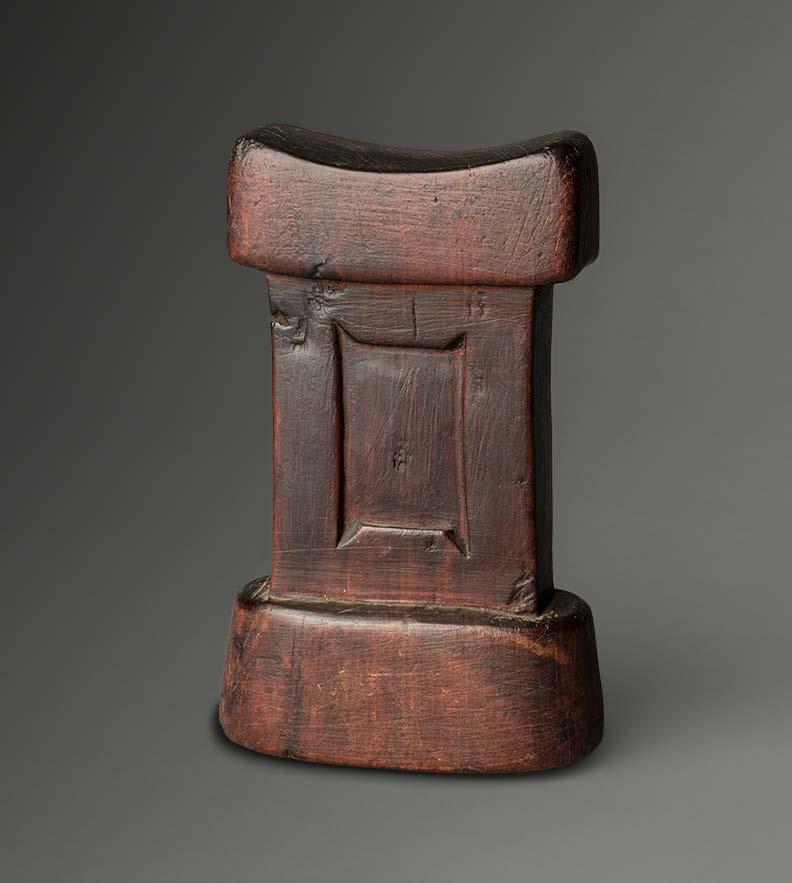
HEADREST : MOTAMELO
LIMPOPO PROVINC E, SOUTH AFRICA
19th/20th century
Wood
Height 16.5 x Width 4.13 x Depth 1.97 ins (16.5 x 10.5 x 5 cm)
PROVENANCE
Inyaka African Art Gallery, Sydney, Australia
Ntwane headrests (metamelo) come in a few configurations but are all simple structures, some with minimalist decorations and others completely unadorned. Typical of one of the styles, this example has a top and base that are slightly thicker than its central panel. The panel has a recessed area in a rectangular shape with pinched corners, reminiscent of the traditional fireplace or sebeso built
into the floor of the courtyard or lapa of most Ntwane homesteads.44
In the publication, Headrests of Southern Africa: The Architecture of Sleep, an image, taken in 2009, of Dikeledi Mathebe shows her holding a headrest in the same style as the present example. Mathebe, from the Moshate area of Ntwane, had owned her headrest since adolescence.45
83 headrest : motamelo 14

OVAHIMBA: NAMIBIA/ANGOLA
The last group of upright headrests in this section originated amongst the Himba from the Kaokoland area of northwestern Namibia, bordering on Angola, where the Kunene River runs between the two countries. Historically a semi-nomadic and polygamous people, some still follow customary lifestyles that include elaborate hairstyling, the application of red ocher and fat to their bodies, and the wearing of outfits fashioned from animal hide. In Margaret Jacobsohn’s extensive 1995 thesis,46 she writes:
Ozongwinyu (carved wooden neck-rests) are regarded as fairly new, at least in western Kaoko, as knives to carve wood were not widely available until a few decades ago. Before this, men used stones as ‘pillows’. Men say that the neck rests are
essential for resting without flattening the hair, particularly the ondumbo hairstyle worn by married men. Most of today’s male elders possess an ongwinyu but almost all of these are plain or very simply decorated. On the other hand, the ozongwinyu used by younger Himba men – including those in the middle age sets – are usually intricately carved and decorated.47
The headrests are currently carved by unemployed youth who vie to create the most spectacular designs. However, those young men who go out to work have their hair cut short and do not need or use neck rests.48
85
V
sleeping forms : southern african headrests from the karel nel collection

HEADREST : OZONGWINYU
NAMIBIA
20th century
Wood, ochre, pokerwork, fibre thong
Height 17 x Width 6.34 x Depth 2.95 ins (17 x 16.1 x 7.5 cm)
PROVENANCE
Collected in Kaokoveld, Namibia by Bruce Goodall
While this headrest has the three sections associated with the upright headrest – base, central panel and sleeping platform, – the base of this example is most unusual. It is in two parts and shaped like an inverted funnel that has been split in two. The tall, upside-down funnel shape suggests both skirt and/or legs, giving the headrest a certain female quality. The light wood has been boldly decorated with dark poker work.
By comparison with the tall base of the headrest, the central support is much smaller and less volumetric. Its flat profile has been punctuated with holes, creating a strong
X-shape contained by two equally striking brackets, one on either side. A small ‘dowel’ carved from the same piece of wood joins the legs of the X, adding structural strength. Smaller horizontal rods link the waist of the X to the two brackets, presumably not only for design considerations.
The dark upper platform is concave along its sides and convex at its ends. The whole headrest has been rubbed with red ocher mixed with fat, giving it a warm reddish-brown hue. It is completed by a small thong tied through one of the holes, presumably to facilitate its being carried.
87 headrest : ozongwinyu 15



HEADREST : OZONGWINYU
NAMIBIA
20th century
Wood, ochre, pokerwork, twisted plant fiber thong
Height 6.29 x Width 4.52 x Depth 4.33 ins (16 x 11.5 x 11 cm)
PROVENANCE
Ken Karner, Franschhoek, South Africa
While anthropomorphic in feel, this headrest can also be seen as an abstract interplay of strong solids, bands of colour and definitive voids. The tall central panel consists of two adjacent, rectangular forms which arise from the circular base. Both these rectangles are penetrated by two square holes, creating the impression of two broad ‘legs’ and a smaller central column, which is deeply grooved to reinforce the sense of bilateral symmetry. A central section with a hole through it emerges organically from the top of the abutting rectangles. The same configuration of rectangles is mirrored above the circle. These two emerging from the central body appear to be the ‘arms’ and ‘head’ of the figure.
The powerful, spread-eagled silhouette can also be read as part crocodile, part man, part lizard, a design ubiquitous across much of Sub-Saharan Africa. Moodley writes that, however widespread the use of this symbol is, it needs to be understood within localised knowledge. Her study amongst
the Northern Sotho confirms its association with the male initiation school (koma) and the secret rites of passage into manhood,49 with virility, rainmaking, and procreation being of primary importance.50
The rounded base is striking, with a series of wedges cut out in relief. The wedges that have been chiselled out are darkened with pokerwork, giving an even greater dynamic to this already vital form. Pokerwork is also applied to part of the central circle, while the upper part of the central section suggesting head, shoulders and arms, is in the lightest wood of all. An application of red ocher and fat is evident over the whole headrest surface. The oval sleeping platform ‘rests’ on the arms of the enigmatic central figure, its warm golden-reddish patina matching that of the ‘lower limbs’.
As with the previous example, a thong of leather is still attached to it.
91 headrest : ozongwinyu 16



HEADREST : OZONGWINYU
NAMIBIA
20th century
Wood, ochre, leather thong
Height 5.9 x Width 5.31 x Depth 4.21 ins (15 x 13.5 x 10.7 cm)
PROVENANCE
Collected in Kaokoveld, Namibia by Bruce Goodall
In contrast to the previous two headrests, this example seems to the western eye, architectural rather than anthropomorphic in its design. Symmetrically placed ‘windows’ have been cut through the flat, rectangular central panel in an arrangement reminiscent of a simplified building façade. The centrally placed truncated triangular shape just below the upper platform, is framed by a rectangular void, and suggests a lamp hanging from the ‘ceiling.’ The upper platform complements the visual
reference to a ‘building’, as it projects over the façade as a roof would, with a gentle dip in its center and softly rounded ends. Reinforcing the architectural metaphor is the smooth, perfectly round, and polished base which could suggest a welcoming front portico.
The headrest, made of a light, blonde wood, is colored with a mixture of fat and red ocher, substances generally rubbed onto the body by the Himba.
95 headrest : ozongwinyu 17
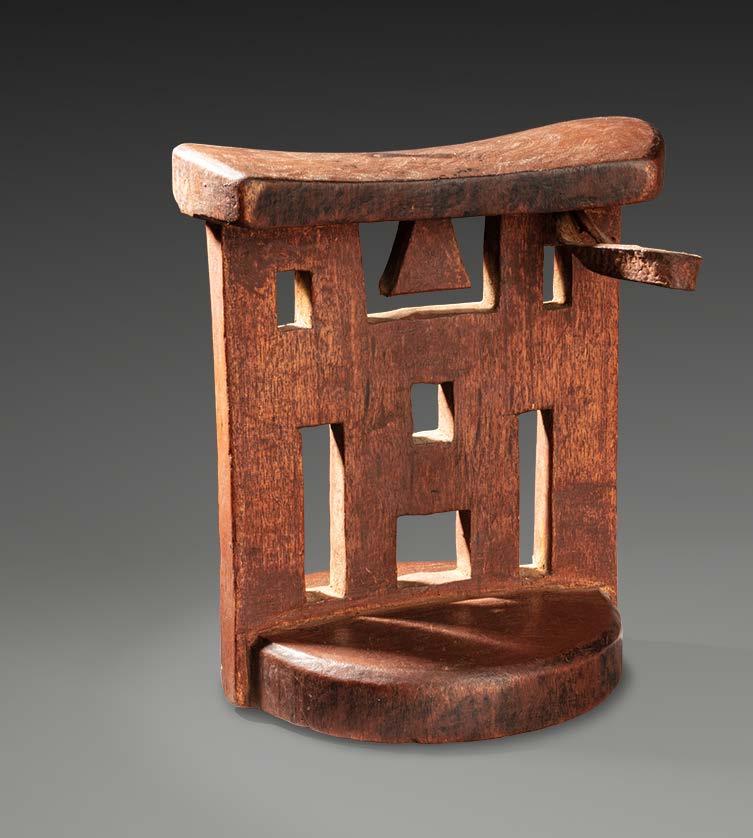

98 headrest : ozongwinyu
HORIZONTAL HEADRESTS
Headrests with a horizontal format most typically belong to the ‘North Nguni’ cluster that includes Zulu and Swazi people. Within this configuration, a wide range of forms and styles are found, especially amongst the Zulu, with a slightly more limited range within a Swazi aesthetic. Much work has been done in the KwaZulu-Natal region linking style to locales and even, at times, to carvers and owners.51 This is particularly so in the case of the Msinga region.52
Most commonly, the long, rectangular headrests that fall within this group, narrow gently upwards from the base towards the sleeping surface. On some headrests, these upper surfaces curve slightly upwards at their ends while on others it is left almost flat. Within those headrests from the ‘Zulu’ constellation, an endless array of configurations is seen in the central section between the sleeping platforms and their bases. Educationalist Jack Grosset identified many patterns in his 1978 thesis on Zulu craft, which include two, three or four solid legs along their length; two, three, or more pairs of bifurcated legs; legs that bulge at the top and taper toward their lower ends; supports in the form of circles, wheels, ovals, loops, u-shapes, and architectonic forms. The amasumpa design, initially associated with the Zulu royal court, is the most well-known and widely recognized pattern. It consists of serried ranks of precisely faceted pyramidal forms that create rich patterns of light and dark. The design was used not only in wood carving but also on ceramics and high-status brass armbands known as izinqxotha.
Contrary to the perception that the ‘Zulu’ are a unified people, the region has been – and remains – one of intense struggles for power, land, and identity, and this is reflected in the diverse headrest styles found there. On a broad scale, there are two distinctive zones – one was the old Zulu Kingdom, established between the Phongola River in the north and the Thukela River in the south and the other, the region below the Thukela River, the British Colony of Natal. These politically distinct territories were both in existence for a large part of the 19th century. Although now amalgamated, the north remains more invested in traditional ways. Distinct from these, the smaller Msinga region that lies on both sides of the Thukela
99

River has a history of resolute difference and distance from the Zulu Kingdom, especially in the 19th century – a time when they saw those from the Kingdom as persecutors.53
The account of the Swazi Kingdom is also one of a fight for survival with its rival, the Zulu Kingdom, both engaging in bitter conflicts over land and resources during the 19th century. This situation was exacerbated by inroads from the surrounding Boer Republics and independent concessionaires with appetites for Swazi land and resources.
Despite these political differences, there are many shared cultural elements and a mutually intelligible language across the three regions. One such shared cultural practice was the commissioning of a pair of headrests (isigqiki in the singular in isiZulu, and sicamelo in siSwati) by the bride, groom, or their families. The bride would take her headrest, or a pair of headrests with her to her husband’s homestead when she married. The move was marked by a reciprocal movement of cattle, the lobola or bride dowry from the groom’s family to the bride’s family homestead in gratitude for the new wife and compensation for the loss of her productivity to her natal family.
Across the regions, the father of the soon-to-be-bride would make a pleated leather skirt from the hide of a cow slaughtered for her. Along with her new conical isicholo hairstyle, it marked her change in status. The fluted vertical grooves carved into the legs of Swazi headrests allude to this skirt, signifying the importance of cattle, the symbolic exchange, its connection to the woman’s fertility, and the conjoining of the two lineages of ancestors. The exchange of cattle bound the families together in the anticipation of children to come. Cattle, considered as an integral part of the family, belonged not only to the living but also to ancestors, now in the spirit world. The ritual slaughter of cattle was – and is still – an important vehicle through which these ancestors are reached.
The sets of four to six or more legs on a headrest symbolically invoke the presence of cattle. These legs either create a distinctly zoomorphic presence, or, when there are many legs, imply the wealth represented by a herd. Some headrests also have tails, slightly swayed backs, and projecting lugs below, suggesting either the umbilicus or penis of the animal. The thought that the form of many headrests allude to these much-loved bovine intermediaries is compelling – as these shapes are intended to draw the attention of the ancestors, facilitating nightly exchanges between the sleepers and their forebears.
101

INORTHERN NGUNI: MSINGA/KWAZULU-NATAL
Msinga, a region of extreme poverty and much factional fighting, is home to diverse families, clans, and chiefdoms that were allocated land by the British government in the mid-19th century. Undoubtedly some movement into and out of the region has happened but going by the names of those still living there, many families have remained where their forebears settled. These include the Qamu, Bomvini, Chunu, Thembu, Mabaso, Sithole, and Zondi lineages. The diversity of headrest styles reflects the continued heterogeneity of people in the region.
103 sleeping forms : southern african headrests from the karel nel collection
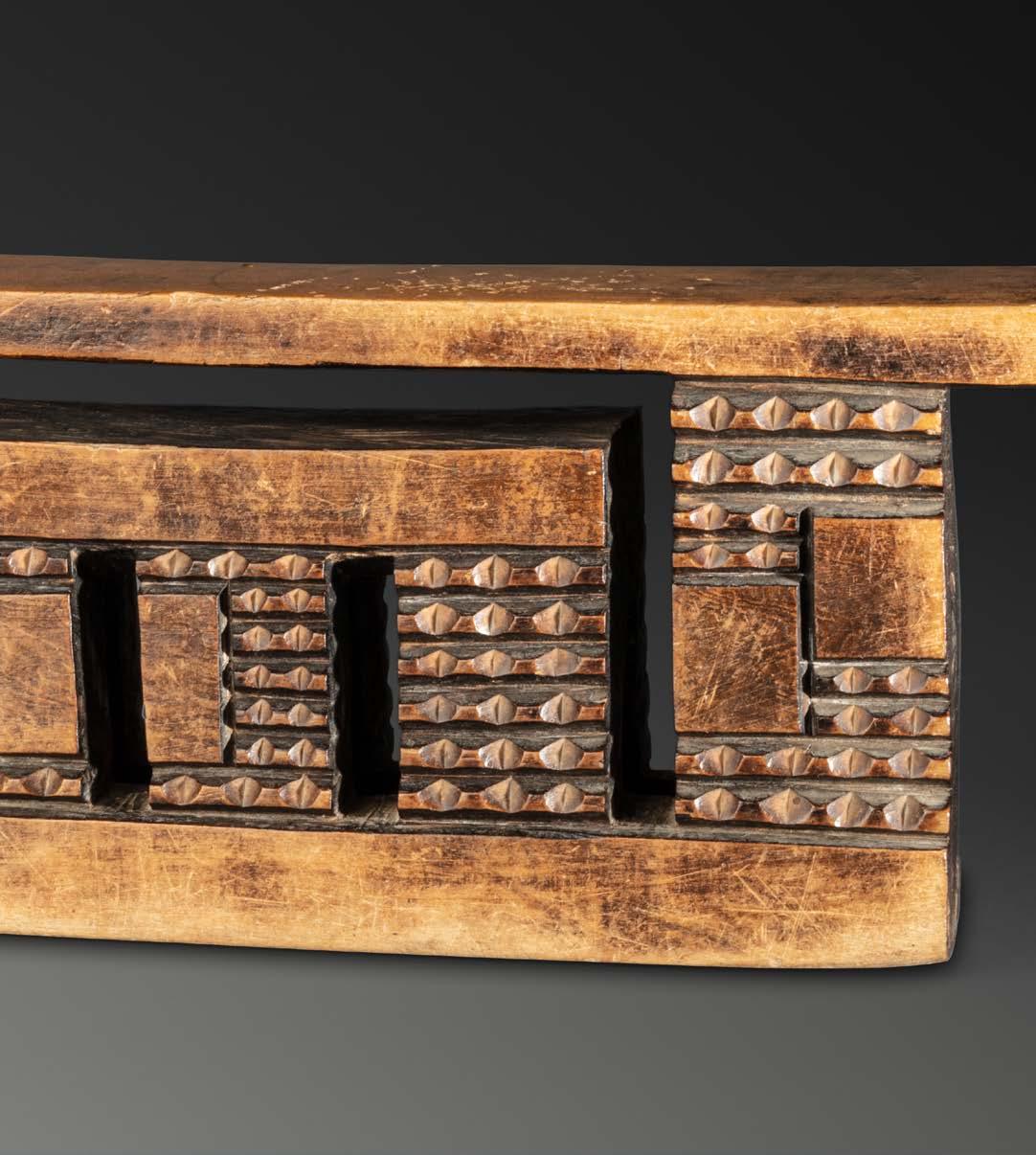
HEADREST : ISIGQIKI
MSINGA, KZN, SOUTH AFRICA
20th century
Wood, pokerwork
Height 5.71 x Width 21.6 x 2.56 ins (14.5 x 55 x 6.5 cm)
PROVENANCE
Vittorino Meneghelli, Johannesburg, South Africa
It is rare for the name of a carver of headrests to be recorded in southern Africa. However, the maker of this work is known. He is Ntuli Mchunu who lived near Emhlumba Mountain in the Weenen area, west of Msinga in KwaZuluNatal.54 He is known for headrests that take the form of a smaller headrest within a bigger one, creating a multistructured object, as is clearly seen in this example. Its distinctive format alternates finely shaped amasumpa with plain wood surfaces, a feature typical of the headrests carved by Mchunu.
The smaller, internal headrest consists of four blocklike columns and a plain horizontal ‘sleeping’ surface that lies neatly just below the actual sleeping platform directly above it. The main headrest brackets the smaller one on all four sides. The two outer columns, taller than the four
inner ones, are also covered with finely chiselled amasumpa designs. The two outer columns and the two innermost columns are punctuated with well-placed undecorated rectangles which highlight the carver’s skill and his confident design sense.
Perfectly symmetrical, every angle and every component of this headrest is skilfully considered and carved. The unembellished smooth wood surface of the upper platform is repeated on the smaller platform just below, as well as the surface of the base. These simple planar facades are contrasted to the rectangles decorated in serried rows of small pyrimidal forms.55
Information in the Headrests from Southern Africa: The Architecture of Sleep identifies four of Mchunu’s headrests, and their original owners.56
105 headrest : isigqiki 18



HEADREST : ISIGQIKI
MSINGA, KZN, SOUTH AFRICA
19th century
Wood, pokerwork
Height 4.84 x Width 17.48 x Depth 2.67 ins (12.3 x 44.4 x 6.8 cm)
PROVENANCE
Vittorino Menenghelli, Johannesburg, South Africa
PUBLICATION HISTORY
Alex Zaloumis, 2000. Zulu Tribal Art. Cape Town: Amazulu Publishers
With its solid columns and deep recesses, this large, horizontal headrest has the elements of grand architecture on a small scale. The two massive outer legs are made even more monumental by the columns carved in low relief on them. The lustrous sleeping platform overhangs the outer columns, providing a ‘roof’ to the structure. The central ‘façade’ consists of a rhythmic interplay between smaller columns and recesses, some thrusting up from the base
and some descending onto the sturdy platform base. A horizontal row of square, coffered panels adorn the base, and a version of the same design is carved vertically on the two innermost columns which flank a deep central recess.
This headrest looks very similar to one carved by Makhebe Khanyile, who lived southwest of Thukela Ferry in the Msinga area.57
109 headrest : isigqiki 19



HEADREST : ISIGQIKI
MSINGA, KZN, SOUTH AFRICA
19th/20th century
Wood, pokerwork
Height 6.1 x Width 22.4 x Depth 3.86 ins (15.5 x 57 x 9.8 cm)
PROVENANCE
Alex Zaloumis, Johannesburg, South Africa
As with the previous example, this headrest plays with the ‘headrest within a headrest’ conceit, a style popular in Msinga and the surrounding regions. Overall, however, this design is simpler than the previous example, but no less striking for that. Here, the sway-backed sleeping platform extends quite some length beyond the central block, seeming to hover above the bulky sub-structure, creating a powerful negative shape within it. The oval cross-section of the sleeping platform, almost like a separate element from the block-like base and its horizontal surface, has acquired a warm honey-brown patina from many years of use.
The two outer supports of the headrest are incised with rectangles, which are in turn parsed into four triangles by a dividing X-shaped motif. The X is filled with its own grid
design. Surprisingly the side view of the headrest reveals that these sturdy supports have a substantial wedge cut into them, creating an allusion to four legs, rather than two.
The block-like form within the headrest evokes a rudimentary dwelling and is attached to the two outer supports by a small block on each side. This entire substructure forms the base and is covered by a diamond pattern that has been meticulously engraved into the dark wood. Some of the patterns in this headrest resemble those used by the carver Nkwishi Shezi,58 who lived in the southern region of Msinga.
Notwithstanding the finely tuned articulation and detailing of the headrest, the overall impression that remains is one of a grand monumentality.
113 headrest : isigqiki 20
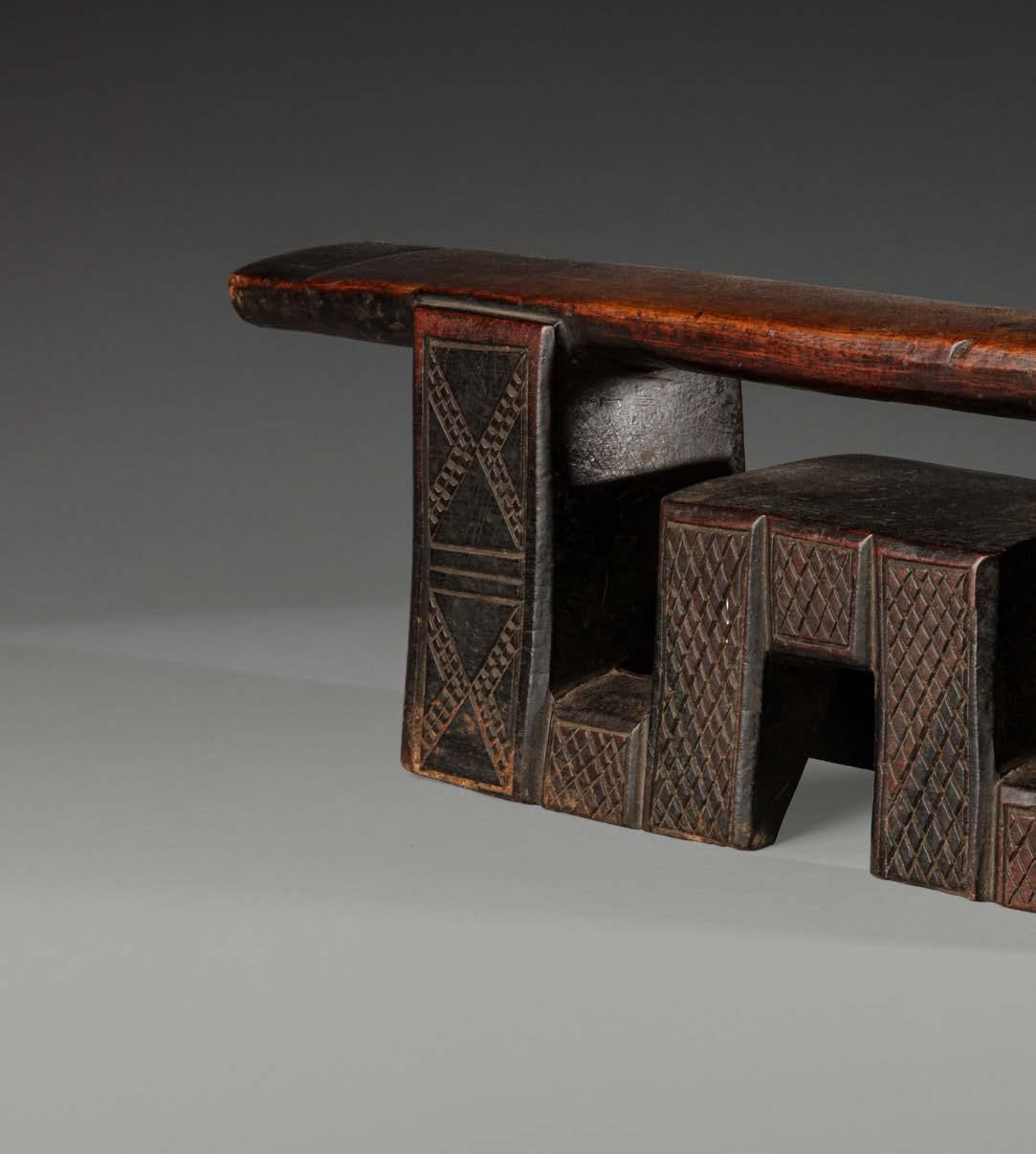


II
ZULU: NONGOMA/ KWAZULU-NATAL
North-east of Msinga lies the heartland of what was the Zulu Kingdom. Here, in the early 19th century, Shaka kaSenzangakhona amalgamated numerous smaller entities through force or persuasion to form perhaps the most famous pre-colonial centralized state in South Africa. Its political structure consisted of distinct social classes. The top tier, close to Shaka and the royal family, were distinguished from commoners by markers of status. These included an elite language, the wearing of izingxotha (brass arm gauntlets) as well as permission to use decorative motifs such as amasumpa (bump designs) on their ceramic vessels, headrests, and meat platters. Klopper confirms that the raised bump or wart design was first used in this region and was associated with the royal inner circle of the Zulu court. Elliott-Weinberg confirms this view with her research tracing a set of majestic objects, taken as plunder during the Anglo-Zulu War of 1879, as originating from one of the homesteads of Cetshwayo kaMpande, king of the Zulu nation of the time.59
117 sleeping forms : southern african headrests from the karel nel collection

HEADREST : ISIGQIKI
NONGOMA REGION, KZN, SOUTH AFRICA
19th/20th century
Wood, pokerwork
Height 5.9 x Width 21.06 x Depth 5.9 ins (15 x 53.5 x 15 cm)
PROVENANCE
Michael Heuermann, Cape Town, South Africa.
Made of a fragrant wood, this headrest is extremely large and heavy, its proportions suggesting that it may also have served as a stool for a man to sit on. The convex sleeping platform ends on both sides with three rows of amasumpa, the famous geometric pyramidal design. The four rectangular legs are also covered with a grid of finely carved amasumpa. The warm, soft feel of the used surfaces attest to its having been used for many years, a prized personal object, while below, the wood retains a certain roughness. While no firm provenance exists for where this headrest was collected, it is of the classic Nongoma style, one usually
associated with the 19th century Zulu Kingdom. After the fall of the kingdom in 1879, the polity lost control of the use and spread of the symbolic language that had been exclusive to its court. Furthermore, during the upheavals of the 19th century, many people fled the kingdom and perhaps replicated this design wishing to retain a connection with the state or a previous king. Headrests with the decorative amasumpa design have thus been found outside of the Zulu heartland and may well have been later creations by people related to the royal court and/or those with such aspirations.60
119 headrest : isigqiki 21



22 and 23 PAIR OF HEADRESTS : IZIGQIKI
KZN, SOUTH AFRICA
19th century
Wood, pokerwork
Height 3.54 x Width 10.7 x Depth 3.42 ins (9 x 27.2 x 8.7 cm)
Height 4.33 x Width 11.02 Depth 4.72 ins (11 x 28 x 12 cm)
PROVENANCE
Egon Guenther, Johannesburg, South Africa
These two dissimilar headrests were acquired as a pair that belonged to a married couple. They differ in that one has two pairs of legs and the other, three; and one is taller and longer than the other. Each has only one pair of legs with the distinctive amasumpa designs, a most unexpected asymmetry. The platform of the smaller headrest also curves downwards at its center much more than the other does. Differences in the headrests belonging to couples may occur when the husband and wife have inherited a headrest from
their respective parents, and so would have been made at different times and associated, at the time of making, with unrelated families. Even if headrests were commissioned from the same carver, the couple may well have requested that they be carved in different styles.61 However, this pair has the same patina, indicating that they were acquired at the same time, made from an identical wood, and used in the same household environment.
: izigqiki
123
pair ofheadrests

124
pair ofheadrests : izigqiki
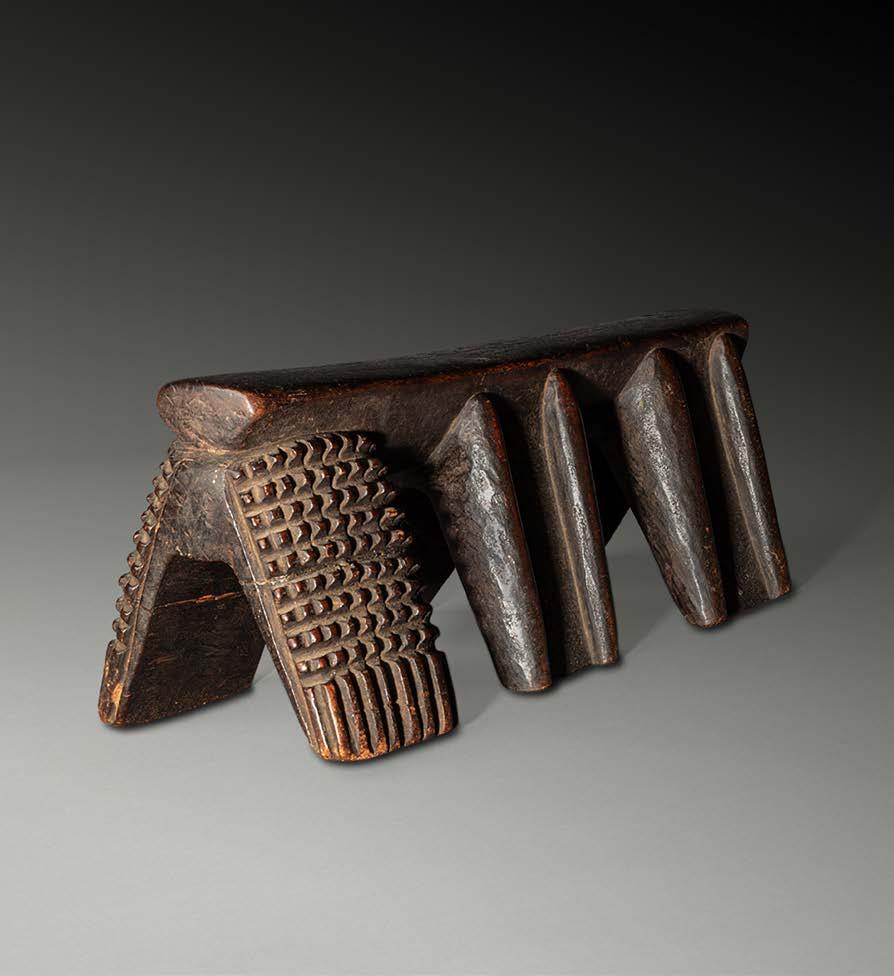
125
pair ofheadrests : izigqiki

III
UNSPECIFIED/KWAZULU-NATAL
Many headrests in collections, some dating back to the early 19th century, are recorded as coming from the broad KwaZuluNatal region but any closer identification remains elusive. The attempt to fine-tune provenance is hindered by the fact that some groups no longer exist, having disappeared from the historical record. Adding to the wealth of designs, the western boundary of KwaZulu-Natal is the contact zone for a range of diverse people living along the border regions of Eswatini and Lesotho, Mpumalanga and Limpopo, and to the north, Mozambique. Through intermarriage and assimilation, the styles of each region will have influenced each other. Headrest No. 24 is a case in point, manifesting as it does features of both Zulu and Swazi aesthetics.
127 sleeping forms : southern african headrests from the karel nel collection

HEADREST : ISIGQIKI
KZN, SOUTH AFRICA
19th century
Wood, pokerwork
Height 7.16 x Width 14.29 x Depth 3.97 ins (18.2 x 36.3 x 10.1 cm)
PROVENAN ce
Maynard Bester, Cape Town, South Africa
PUBLICATION HISTORY
Alex Zaloumis, 2000. Zulu Tribal Art. Cape Town: Amazulu Publishers, p 68–69.
This exceptionally tall headrest stands on finely decorated bifurcated legs that flare gently outwards. The central lug is also rather unexpectedly bifurcated too. The curved sleeping platform dips towards the centre as if weighed down by the sizeable lug below. The platform extends some way beyond the supporting legs and terminates in neat ovals carved with a refined set of vertical grooves. The vertical grooves down the length of the four legs are crossed by a set of horizontal
lines – an elegant touch. The large umbilical lug is engraved with series of parallel lines that abut along a diagonal. The quality of the carving is both restrained and pleasing on a headrest remarkable for its long-legged elegance.
This headrest almost certainly comes from the wider KwaZulu-Natal region, but a more precise location is not known.
129 headrest : isigqiki 24

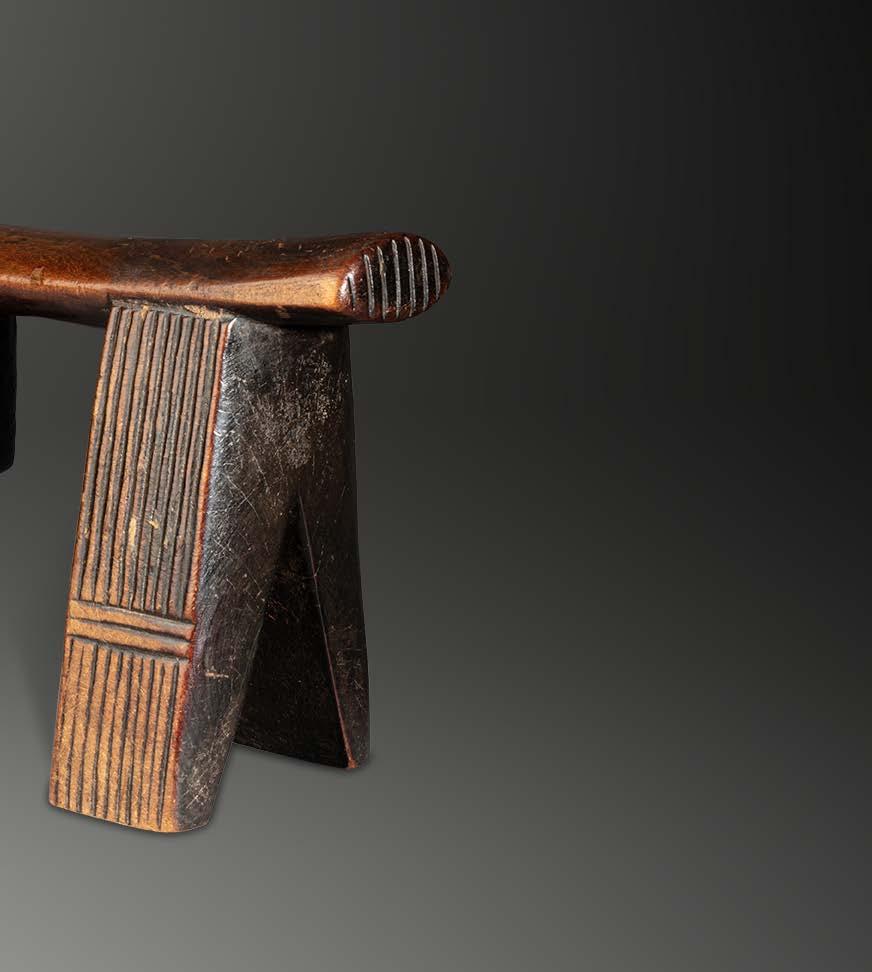
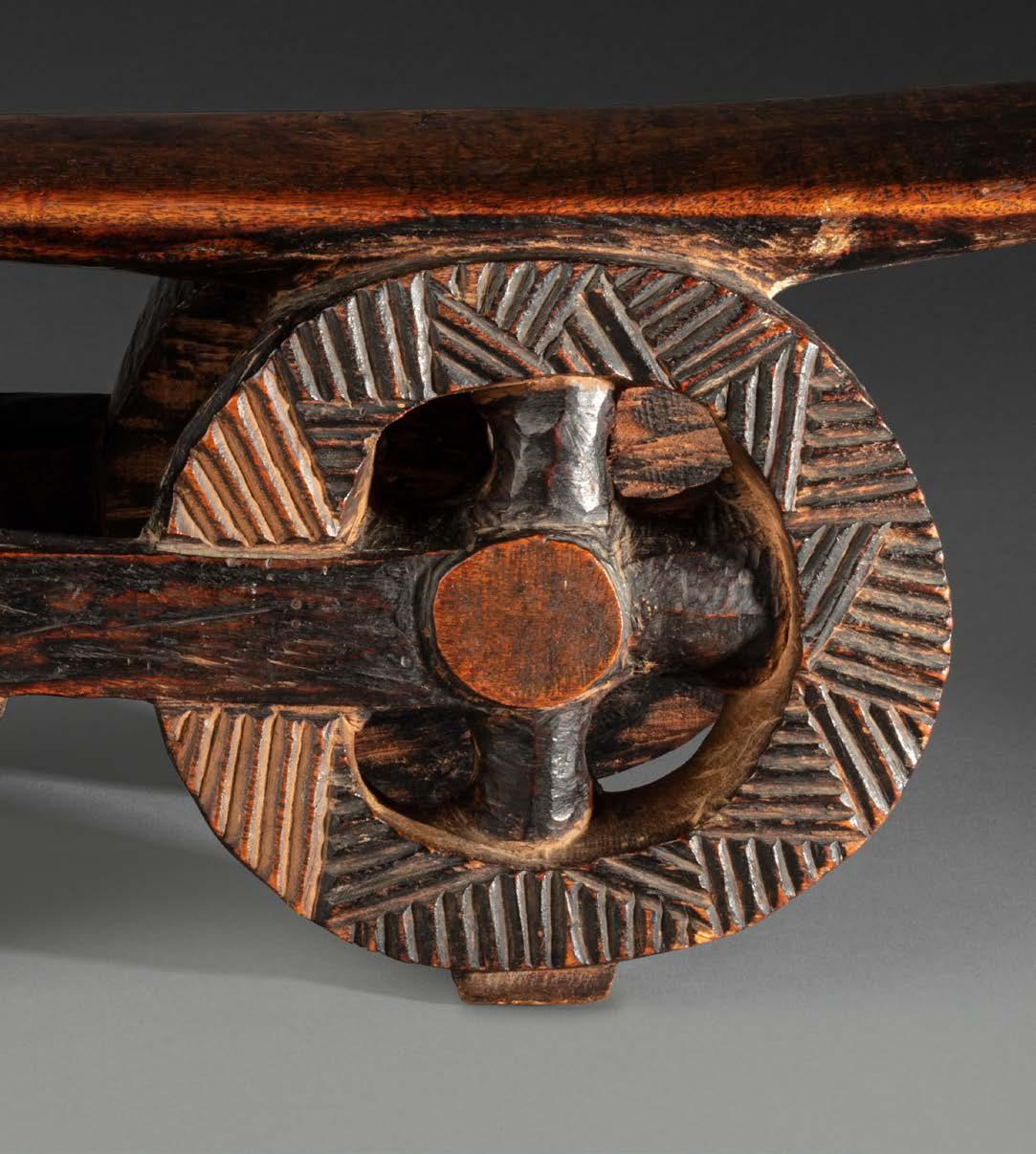
HEADREST : ISIQGIKI : SICAMELO
POSSIBLY ESWATINI/NORTHERN KZN, SOUTH AFRICA
19th century
Wood, pokerwork
Height 6.29 x Width 16.73 x Depth 5.12 ins (16 x 42.5 x 13 cm)
Headrests with ‘wheel’ motifs occur fairly frequently but are carved in a variety of styles that don’t always appear to be closely related to each other.62 Early Northern Nguni examples in the Johannesburg Art Gallery collection have circular forms in abstract compositions that bear no resemblance to wheeled forms of transport. The concept of the wheel and the desire to travel may have come to be associated with these circular forms, an idea which is confirmed by the name for the grooved parallel lines that decorate the outer sides of the wheels of this headrest. Similar parallel grooved decorations on the legs of several headrests from the Msinga region63 are called ndlela ziyegoli which means ‘on the way/road to Johannesburg.’64 The addition of the crossbar that runs from the center of one
wheel to the other, reinforces the analogy of a train as it suggests the piston that drives the wheels of the engine forward. The much-used sleeping platform of the headrest extends beyond the wheel ‘bogie’ and its oval ends have the same vertical striations as was seen on No. 24.
During the second half of the 19th century and well into the 20th, steam trains played an important role in transporting migrant workers from rural areas to mines and city centres for work and back. Karel Nel is of the view that the steam engines crossing the landscape at speed must have made an indelible impression on rural communities, and perhaps came to be identified as an immense power object in the ‘new’ world, much as the bull was in the old world.
133 headrest : isiqgiki : sicamelo 25
PROVENAN ce
Egon Guenther, Johannesburg, South Africa



IV SWAZI: ESWATINI
Eswatini is still ruled by the last absolute monarchy in Africa, one of the few remaining in the world. The headrests from this region show a degree of stylistic conformity despite the nation being, historically, an amalgam of many different cultural groups. The Dlamini clan became the core of the Swazi Kingdom, colonising southern Eswatini, probably in the 1760s and 1770s. The land was fertile and well-watered, and already occupied by numerous chiefdoms, many of whom were Sothospeaking and included some of Tsonga affiliation. Through assimilation and conquest, the Swazi royal house brought the region under its control, and the uniformity in headrest style may reflect the extent of the political success of this centralised state.
As noted above, the many shared customs between the Swazi and the Zulu include the horizontal format of the headrests, the fact they were acquired at the time of marriage, and that both women and men slept on them. However, a feature that distinguishes the Swazi examples is the frequent appearance of a dark, pleated design of vertical grooves on the two flared legs at either end of the sleeping surface. This pleated appearance evokes the dense, dark folds of the isidwaba, the marriage skirt that links the bride-wealth cattle and married women. A further unique element is the two triangular or semi-circular designs, said to be tindlebe or ears, also a euphemistic term for the labia minora,65 situated on the upper surface above each set of legs. This notion concurs with author and collector Gordon Crawford’s view, who asserts that headrests were understood to represent wives. However, when considering the example following (No. 26), the male bovid allusion is unmistakable.
137 sleeping forms : southern african headrests from the karel nel collection
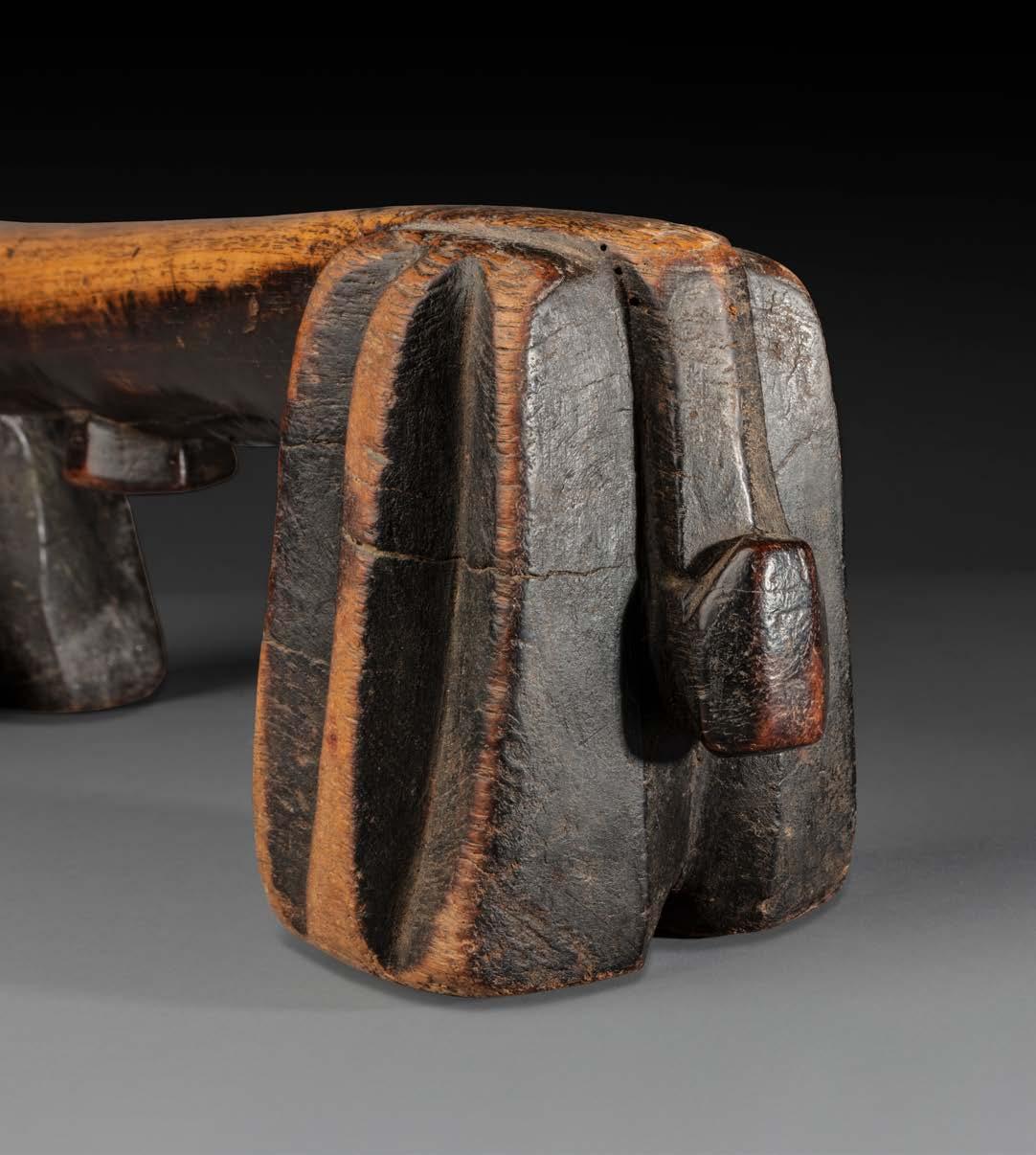
HEADREST : SICAMELO ESWATINI
19th century
Wood, pokerwork
Height 5.31 x Width 19.29 x Depth 3.7 ins (13.5 x 49 x 9.4 cm)
PROVENANCE
Alex Zaloumis, South Africa
Acquired by Zaloumis from a Dlamini princess of the Royal Household.
This early Swazi headrest is said to have been acquired from one of the princesses of the Dlamini royal family. Its long and lustrous sleeping platform stretches between two chunky sets of legs and culminates on either side in insouciant upturned ‘tails’. The central boss below the warm, honey-colored sleeping platform represents the umbilicus, the point of connection between offspring and the mother. Years of usage has worn off some of the dark pokerwork on the legs, which is still there on the umbilical lug. One set of the boldly grooved legs is slightly taller than
the other, perhaps suggesting the upper part of a bull’s body. The perky upturn at either end suggests a rudimentary head, a tail, or a penis. These male elements, together with the headrest’s female aspect, represented by the boldly fluted skirt/legs, means that the headrest becomes the perfect symbolic materialization of the social and spiritual union of a man and a woman.
A similar example has been published in The Art of Southern Africa: The Terence Pethica Collection. It was said to have been collected in 1870.66
139 headrest : sicamelo 26



27 and 28 PAIR OF HEADRESTS : TÍCAMELO ESWATINI
19th century
Wood, pokerwork
i) Height 6.41 x Width 15.16 x Depth 4.52 ins (16.3 x 38.5 x 11.5 cm)
ii) Height 6.29 x Width 15.74 x Depth 4.13 ins (16 x 40 x 10.5 cm)
PROVENANCE
Potchefstroom University Ethnographic Collection; Male headrest accession number 09/1152; Female headrest accession number V1151.
Ken Karner, Franschhoek, South Africa
PUBLICATION HISTORY
The Architecture of Sleep, p 33.
A pair of gendered headrests like this is exceptionally rare. Candidly detailed male and female elements appear on the respective pieces. A penis-like form accentuates both ends of the larger headrest, while a raised, vulva-like detail characterises the ends of the more svelte of the pair.
Side views reveal their well-rounded, leg-like struts and their deep, horizontal torsos, which make this pair seem positively bovid. The belly-like sag, with protruding faceted navel below the sleeping platform, amplifies this zoomorphic reading. Human fecundity, the very premise of marriage, is linked to the fertility of the beloved cattle that are central to the family’s livelihood, the clan’s prosperity, and the economy of the group as a whole. The cattle imagery directly invokes the ancestral world, which forms an integral part of the entire social structure and connects the sleeper with his or her forebears.
The substantial wearing away of the poker work on the chamfered legs of both headrests and their identical gleaming surfaces point to many years of usage in a single household.
In summing up, this pair of headrests highlights once more the centrality of cattle to the cultures in this region, their function in braiding together family lineages across the ages, creating alliances beyond the immediate family group. In these two headrests, the link to human fecundity is made explicit, as it was in the pubic triangles and the nubile breasts on the caryatid-like Shona headrests.
Although the nexus of ideas in the headrests are very closely related, the astonishing variety of mainly abstract forms attests to the creative ingenuity and pleasure of the carvers working within the parameters of certain accepted proportions.
: tícamelo
143 pair of
headrests







Nessa Leibhammer biography
Nessa Leibhammer is an independent researcher, writer and curator with a particular interest in material culture approached from an interdisciplinary position. After studying architecture at the University of Cape Town, Leibhammer completed a degree in Fine Arts at the University of the Witwatersrand. Her Master’s Degree in Precolonial Studies took her to the Neolithic site of Catalhöyük in Turkey where she explored how archaeologists create and present knowledge about the past through imaging. Leibhammer was an honorary research fellow at the Institute of African Studies at the University of Cambridge in 2012/3 and currently holds the position of honorary research fellow at the Archive and Public Culture Research Initiative at the University of Cape Town.
Her publications include Jackson Hlungwani (co-ed) forthcoming, Tribing and Untribing the Archive (co-ed) and Dungamanz: Stirring Waters (ed) and she has curated exhibitions such as Jackson Hlungwani: A New Jerusalem; Gae Lebowa/ Home North and Matters of Spirit. Her co-curated exhibitions include Jackson Hlungwani: Alt and Omega, Dungamanzi: Stirring Waters and Evocations of the Child: fertility figures from southern Africa.
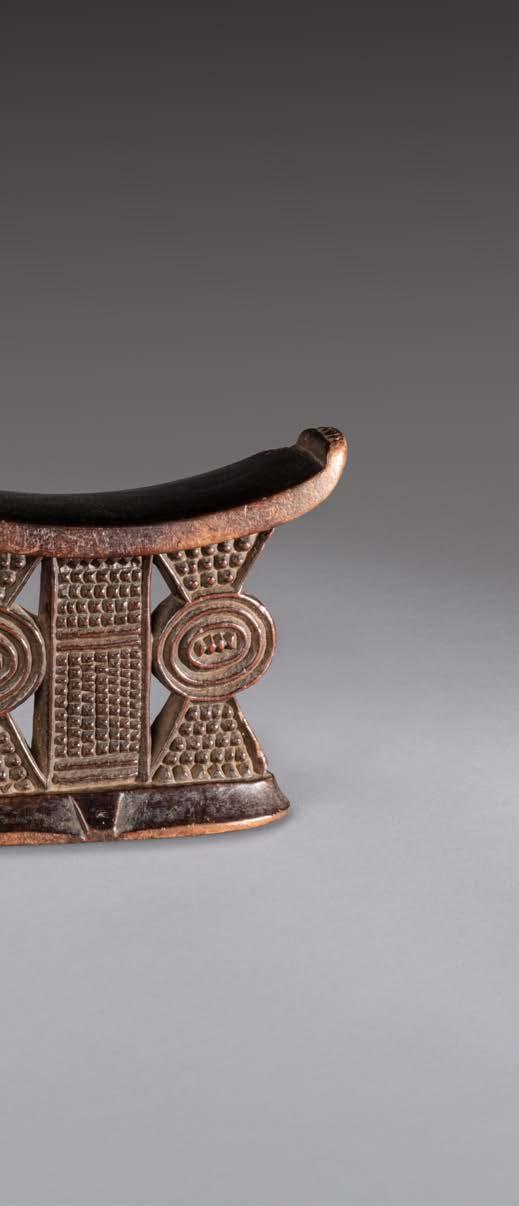
151 nessa leibhammer biography

Notes
1 See N.M. Leibhammer, 2022. Containers for the Living and the Shades: Vessels from Southern Africa. New York: Jacaranda.
2 Niangi Batulukisi in Roy Sieber and Herreman, F., 2000. Hair in African Art and Culture. New York: The Museum for African Art. p 27.

3 Ibid, p 186.
4 Nessa Leibhammer, 2011. ‘Fluid of the Ancestors: Water and the Spirit Realm in Past and Present Black Southern African Thought and Practice’ in Freschi, F. (ed.) Water, the [Delicate] Thread of Life, Standard Bank Gallery, Johannesburg.
5 Manuel Jordan, 2000. ‘Hair Matters in South Central Africa’ in Roy Sieber and Frank Herreman, 2000. Hair in African Art and Culture. New York: The Museum for African Art. p 142.
6 William Dewey, 1993. Sleeping Beauties: The Jerome Joss Collection of African Headrests at UCLA. Los Angeles: University of California and Fowler Museum of Cultural History, p 21.
7 Karel Nel, 2021. ‘The Architecture of Sleep: The Significance of Headrests’ in Burroughs, E., Leibhammer, N.M., and Goodall, B. (eds.), Headrests from Southern Africa: The Architecture of Sleep, Milan, Italy: 5 Continents Editions, p 25.
8 Borneo and Madagascar.
9 Dewey, 1993, p 17.
10 Connah, Graham,1981. Three thousand years in Africa: Man and his environment in the Lake Chad region of Nigeria. New York: Cambridge University Press. pp 99–196.
153 notes
11 https://drum.lib.umd.edu/handle/1903/2416 (accessed 10 February 2022).
12 The collective terms ‘Shona’, ‘Tsonga,’ ‘Zulu,’ ‘Himba,’ ‘Swazi,’ and ‘Ntwane’ have been used throughout this catalogue. These terms have often been challenged as inaccurate oversimplifications of the true nature of African societies and largely the result of colonial-era classifications. However, for ease of reading, we have retained these terms but wherever information has been available to give a more appropriate identification, it has been included.
13 See N.M. Leibhammer, 2022. Containers for the Living and the Shades: Vessels from Southern Africa. New York: Jacaranda.
14 Rayda Becker, 1999. Tsonga Headrests: The Making of an Art History Category, PhD thesis, Johannesburg: University of the Witwatersrand, p 159.
15 Dewey, 1993, p 24.
16 Frank Jolles presents an argument for the linking of styles to the izigodi, an administrative area usually based on physical boundaries. Jolles, F., 2001, ‘Tradition and innovation: woodcarvers at the confluence of the Umzinyathi and Umngeni rivers, KwaZulu-Natal, South Africa.’ In Southern African Humanities, Vol 13, pp 97–124; See also Burroughs, Leibhammer and Nel, 2021.
17 Dewey, 1993, p 120.
18 Including the Taυara, Shangwe, Goυa, and Budya.
19 Including the Shawasha, Haraυa, Nohwe, Hera, Njanja, Mbire, Nobvu, Vakwachikwakwa, Vakwazvimba and Tsunga.
20 Including the Duma, Jena, Mari, Goυera, Nogoυa, and Nyubi.
21 Including the Hungwe, Teυe, Unyama, Karombe, Nyamuka, Bunji, Domba, Nyatwe, Guta, Bvumba, Jindwi, and Boca.
22 He was a consulting physician and specialist in tropical diseases who served in Malawi.
23 Dewey, 1993. p 106–115.
24 This he places around the Makoni, Mutasa, Mutare, and Nyanga regions but also including Mozambique. He notes that these are often labeled Karanga or Maswina, p 107.
25 Dewey, 1993, Fig. 10, p 135. Found amongst those who speak the Zezuru dialect around Nharira and the Charter District.
26 Tom Phillips (ed) 1996. Africa Art of a Continent. New York: Guggenheim Museum Publications, p 87.
27 Müller, H.P.N., and Snellerman, J.F.,1893, Industrie Des Cafres Du Sud-Est De L’Afrique. Collection Recueillie Sur Les Lieux et Notice Ethnographique. Leyde: E.J. Brill.
28 Dewey, 1993, p 102.
29 Natalie Knight 2007, ‘Transforming Fate into Destiny’ in Leibhammer, N. (ed) Dungamanzi: Stirring Waters, Johannesburg: Wits University Press, pp 62-65.
30 These autochthonous communities would have most likely been Sotho-speaking polities who had been living in the area for many centuries.
31 Patrick Harries, 1989, ‘Exclusion, Classification and Internal Colonialism: The Emergence of Ethnicity Amongst the Tsonga-Speakers of South Africa’ in Leroy Vail (ed) The Creation of Tribalism in Southern Africa, London: James Curry and Berkley and Los Angeles: UCLA Press, p 83.
32 Anitra Nettleton, 2007. African Dream Machines. Johannesburg: Wits University Press.
33 Junod, H.A. 1962. Life of an African Tribe, I, Social Life. New York: New Hyde, p 16.
34 Junod, H.A. 1962, Life of an African Tribe, II, Mental Life. New York: New Hyde, p 128.
35 Accession number: JAG 1987.3.40 and 41.
36 Art and Ambiguity: Perspectives on the Brenthurst Collection of Southern African Art 1991. Johannesburg: Johannesburg Art Gallery, p 67.
37 Ibid p 63.
38 Terence Pethica, Nettleton, A and Klopper, S, 2007. The Art of Southern Africa: The Pethica Collection. Milan: 5 Continents, pp 94-95.
39 Burroughs, Leibhammer and Goodall pp 298–299.
40 Art and Ambiguity, p 66.
41 Terence Pethica, Nettleton, A and Klopper, S, p 170.
42 Kevin Conru 2002. The Art of Southeast Africa from the Conru Collection. Milan: 5 Continents, p 60
154 notes
43 Dewey, 1993. p 79.
44 Burroughs, Leibhammer and Goodall, 2021, pp 378–9.
45 Ibid, p 405.
46 Margaret Jacobsohn, 1995, Negotiating Meaning and Change in Space and Material Culture: An ethnoarchaeological study among semi-nomadic Himba and Herero herders in north-western Namibia. PhD Department of Archaeology, University of Cape Town.
47 Ibid, p 150.
48 Ibid, p 150.
49 Shiona Moodley, 2008, ‘Koma: The Crocodile Motif in the Rock Art of the Northern Sotho’ in The South African Archaeological Bulletin, Vol. 63, No. 188 (Dec., 2008), pp 116–124. Published by: The South African Archaeological Society.
50 Ibid, p 122.
51 Jolles, 2001; Sandra Klopper, 1992, The Art of Zulu-Speakers in Northern Natal-Zululand: An investigation of the History of Beadwork, Carving and Dress from Shaka to Inkatha. PhD Thesis, University of the Witwatersrand.; Catherine Elliott Weinberg, 2020, ‘Presences in the archive: Amagugu (treasures) from the Zulu Kingdom at the British Museum’ in Chris Wingfield, John Giblin & Rachel King (eds.) The pasts and presence of art in South Africa Technologies, Ontologies and Agents. Cambridge: Mc Donald Institute for Archaeological Research, pp. 169–182.
52 This detailed information can be found in the recently published Headrests from Southern Africa: The Architecture of Sleep, 2021.
53 Buthelezi, M., 2012. Sifunda umlando wethu” (We are Looking for our History), Oral Literature and the Meanings of the Past in Post-Apartheid South Africa, PhD, Columbia University; Alcock, C., 2011. ‘A brief history of the Mchunu and Mthembu tribes’ in Imithetho yomhlaba yaseMsinga: The living law of land in Msinga, KwaZulu-Natal, Institute for Poverty, Land and Agrarian Studies (PLAAS), the University of the Western Cape, Research Report 43, p 22.
54 Burroughs, Leibhammer and Goodall, pp 224–225.
55 Ibid, pp 196 -7, 225–226.
56 Ibid, pp 196-7, 225–226.
57 Ibid, p186.
58 Ibid, p 58.
59 Elliott Weinberg, C., “Presences in the Archive: Amagugu from the Zulu Kingdom at the British Museum”, in Wingfield, C., R. King and J. Giblin, The Pasts and Presence of Art on South Africa: Technologies, Ontologies and Agents, Manuscript from the McDonald Institute, pp 345–71.
60 Burroughs, Leibhammer and Goodall, 2021. The Architecture of Sleep features several headrests from the Msinga region with amasumpa designs. These are reproduced on pp 222 (carver Mkhulu Ngqulunga/ owner Mbulawa Japha Ntshaba); 225 (carver Ntuli Mchunu/owner MaSithole Choncho and carver Ntuli Mchunu/owner MaMkhize Choncho); 226 (carver Ntuli Mchunu/owner Ntabamhlope Mkhize and carver Ntuli Mchunu/owner MaTshaba Thusi); 227 (carver Sigidwane Choncho/owner Mamkhize Choncho).
61 Ibid, pp 132-133.
62 Africana Notes and News December 1987, Part 27, no 8, p 306, Fig. no 151. This headrest, now in the Johannesburg Art Gallery Collection Accession number JAG 1987.3.111 has four wheels without spokes or a piston shaft. The wheels have grooved channels carved into their circumferences and the upper platform has a central lug projecting below its sleeping surface. It was collected by the Rev. AA Jaques, in the Bushbuckridge (Graskop) area of the eastern Transvaal (now Mpumalanga) and it is described as ‘Shangaan’.
63 Burroughs, Leibhammer and Goodall, 2021, pp 244–245.
64 Ibid, p 243.
65 Gordon Crawford, 2008, Sicebile: Swaziland’s Cultural Adornment and Artefacts, Durban: Atlas Printers, p 55.
66 The Art of Southern Africa: The Terence Pethica Collection, 2007. Milan, Italy: 5 Continents, pp 138–139.
155 notes
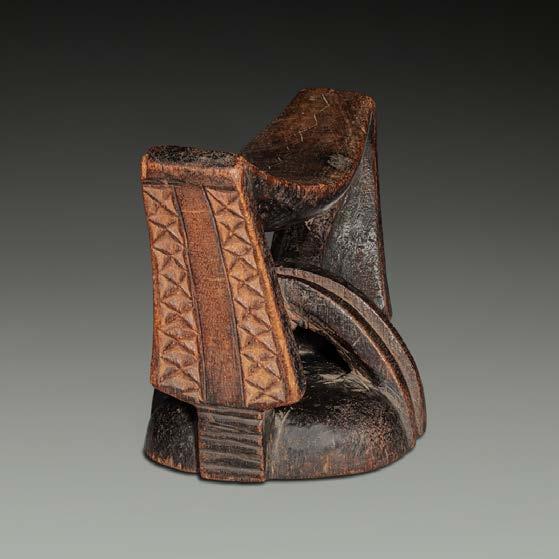
156 pair of headrests : tícamelo www.jacarandatribal.com dori@jacarandatribal.com T +1 646-251-8528 New York City, NY 10025 PRICES AVAILABLE ON REQUEST
ART AND ANTIQUES FROM AFRICA, OCEANIA AND THE AMERICAS








































































































